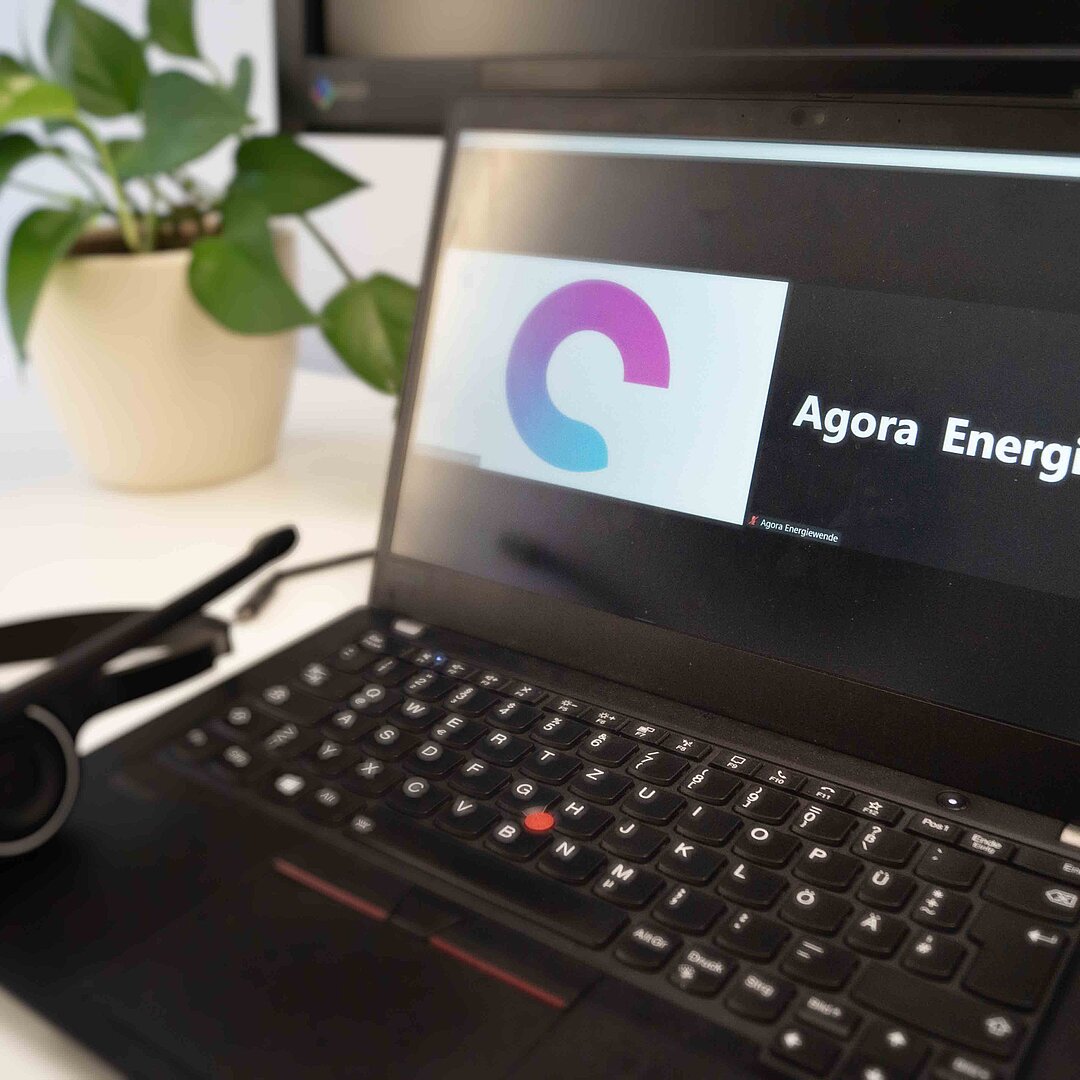-
Fossil gas use in Europe can be halved by 2030 and completely phased out by 2050.
This is possible while maintaining today’s level of industrial production and fully ensuring security of supply, without disruptive behavioural changes. The phase-out requires a fast ramping up of energy efficiency and renewable energy, as well as the electrification of applications in the buildings and industry sectors.
-
By 2040, EU greenhouse gas emissions could decline by 89% relative to 1990 levels, with a projected remaining Union greenhouse gas budget for the 2030–2050 period of 14.3 Gt.
The sectoral transition pathways developed in this report show that based on latest technological progress, an EU greenhouse gas reduction target of 90% by 2040 is realistic. It would avoid 3.3 Gt more greenhouse gas emissions than projected in the EU’s 2020 Climate Target Plan.
-
Europe will need a significant amount of renewable hydrogen to become climate neutral, but the demand by 2030 could be only a fifth of that foreseen in REPowerEU.
By prioritising direct electrification and reserving its use for no-regret applications, the EU would need only 116 TWh of renewable hydrogen by 2030, compared to 666 TWh in REPowerEU. This is more cost-effective, more realistic from a security of supply perspective and consistent with the hydrogen sub-targets in the new Renewable Energy Directive. The REPowerEU target should thus be revised.
-
EU rules on gas, hydrogen, and infrastructure planning must reflect the projected rapid
decline in fossil gas demand.
(1) A new impact assessment is needed for the EU gas and methane package. (2) Governments should evaluate the impact of the decline in gas demand on gas supply and distribution infrastructure, and when updating their National Energy and Climate Plans. (3) The sale of new fossil gas-burning equipment in buildings should end quickly.
- Format
- Study
- Date
- 4 May 2023
Breaking free from fossil gas
A new path to a climate-neutral Europe

Preface
In view of the accelerating climate crisis, the European Union has set itself a legally binding target to be climate neutral by 2050 at the latest. Climate neutrality means no more burning of unabated fossil fuels. No oil, no coal, no fossil gas.
The escalation of Russia’s war against Ukraine and the resulting fossil gas crisis put a spotlight on Europe’s high dependency on imports of cheap Russian pipeline gas. The REPowerEU plan is a testament to the resolve of European leaders to rapidly end this dependency and to find a balance between structurally reducing demand and replacing Russian gas with imports from elsewhere or non-fossil molecules such as renewable hydrogen and biomethane.
Against this background, this report presents a structural transition pathway away from fossil gas use by 2050 based on detailed sectoral modelling of the energy, buildings, and industry sectors. We also draw several insights from this work with implications for EU energy and climate policy-making.
Key findings
Video
By loading this video you consent to the processing of your data and the setting of cookies by the external service provider YouTube. See our privacy policy for details.
In this video, Matthias Buck introduces the main findings of the report "Breaking free from fossil gas - a new path to a climate-neutral Europe".
Bibliographical data
- Authors
- Andreas Graf, Murielle Gagnebin, Matthias Buck (all Agora Energiewende)
- Publication number
- 292/02-S-2023/EN
- Version number
- 1.1
- Publication date
-
4 May 2023
- Pages
- 86
- Suggested citation
- Agora Energiewende (2023): Breaking free from fossil gas. A new path to a climate-neutral Europe.
- Project
- This publication was produced within the framework of the project Scenarios on the future of fossil gas in the EU.
Downloads
-
Study
pdf 3 MB
Breaking free from fossil gas
A new path to a climate-neutral Europe
-
Attachment
pdf 6 MB
Breaking free from fossil gas
A new path to a climate-neutral Europe (Technical document)
All figures in this publication
EU Gas Exit Pathway: technological pathway towards fossil gas phase-out, EU-27
Figure ES 1 from Breaking free from fossil gas on page 8
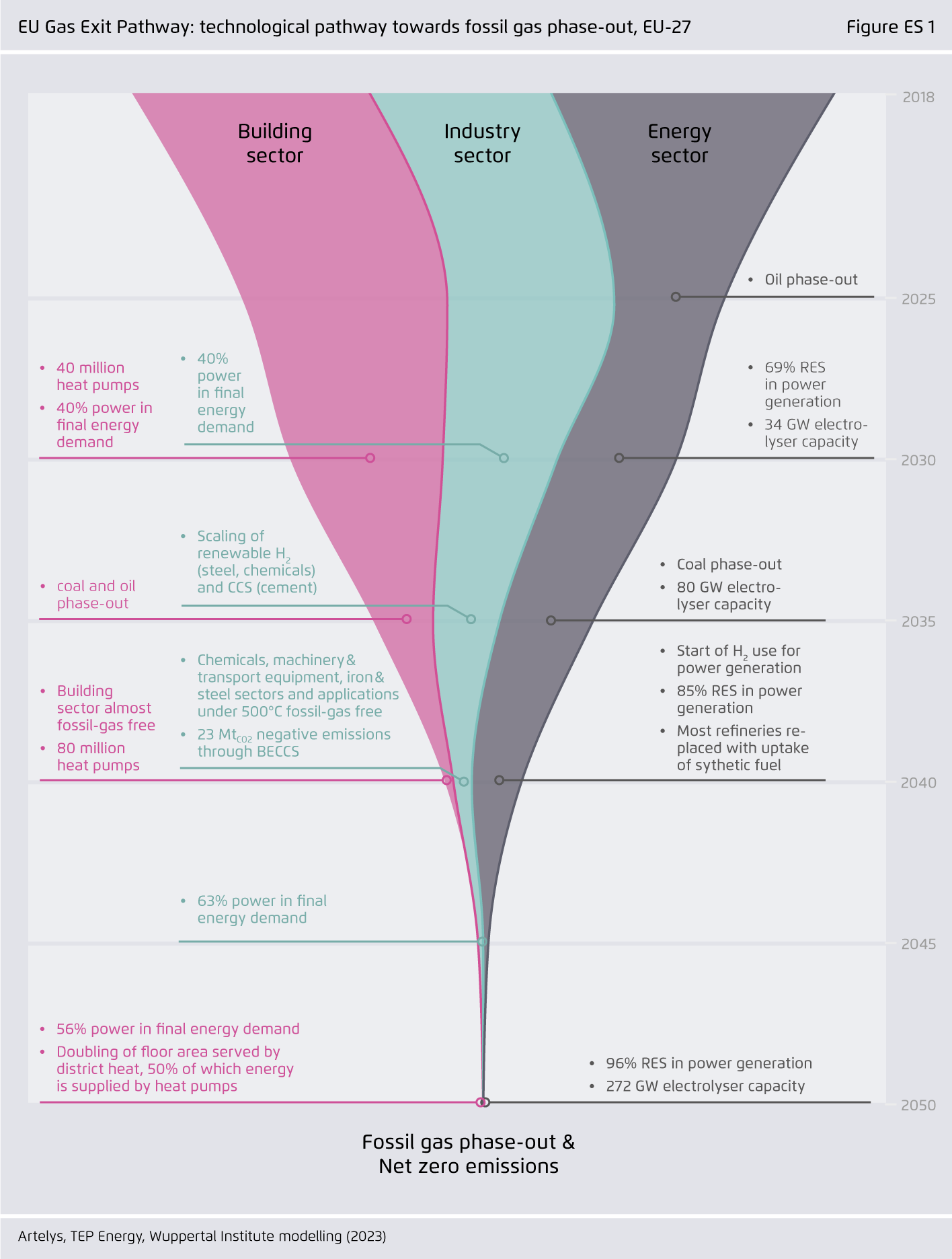
Under consideration of the Creative Commons license CC BY (attribution) the image may be further processed in any format or medium (also commercially, also in modified form), as long as the author is mentioned and a link to the license is given.
GHG emissions by sector
Figure ES 2 from Breaking free from fossil gas on page 10
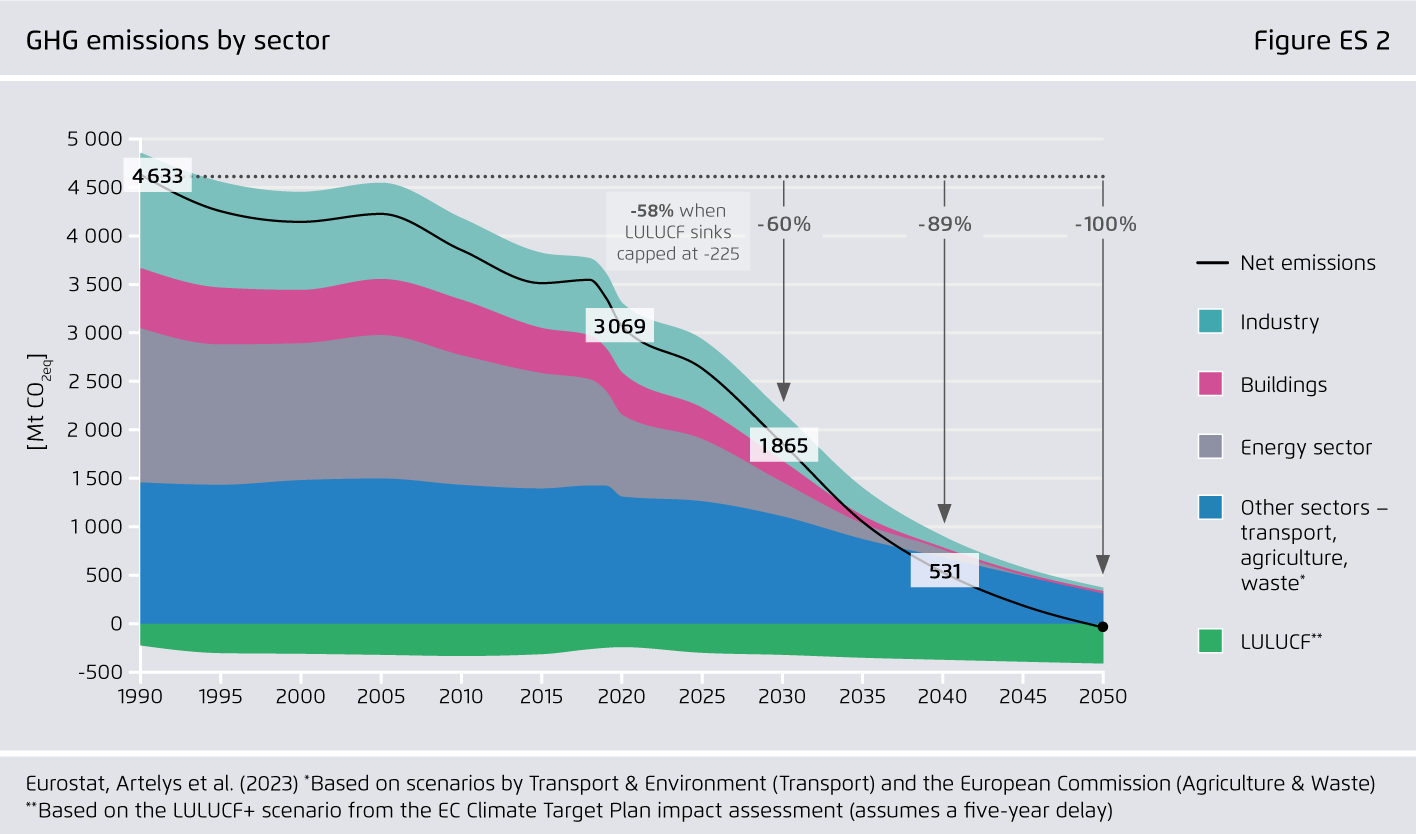
Under consideration of the Creative Commons license CC BY (attribution) the image may be further processed in any format or medium (also commercially, also in modified form), as long as the author is mentioned and a link to the license is given.
Supply by source and sectoral demand for renewable hydrogen and derivatives
Figure ES 3 from Breaking free from fossil gas on page 11
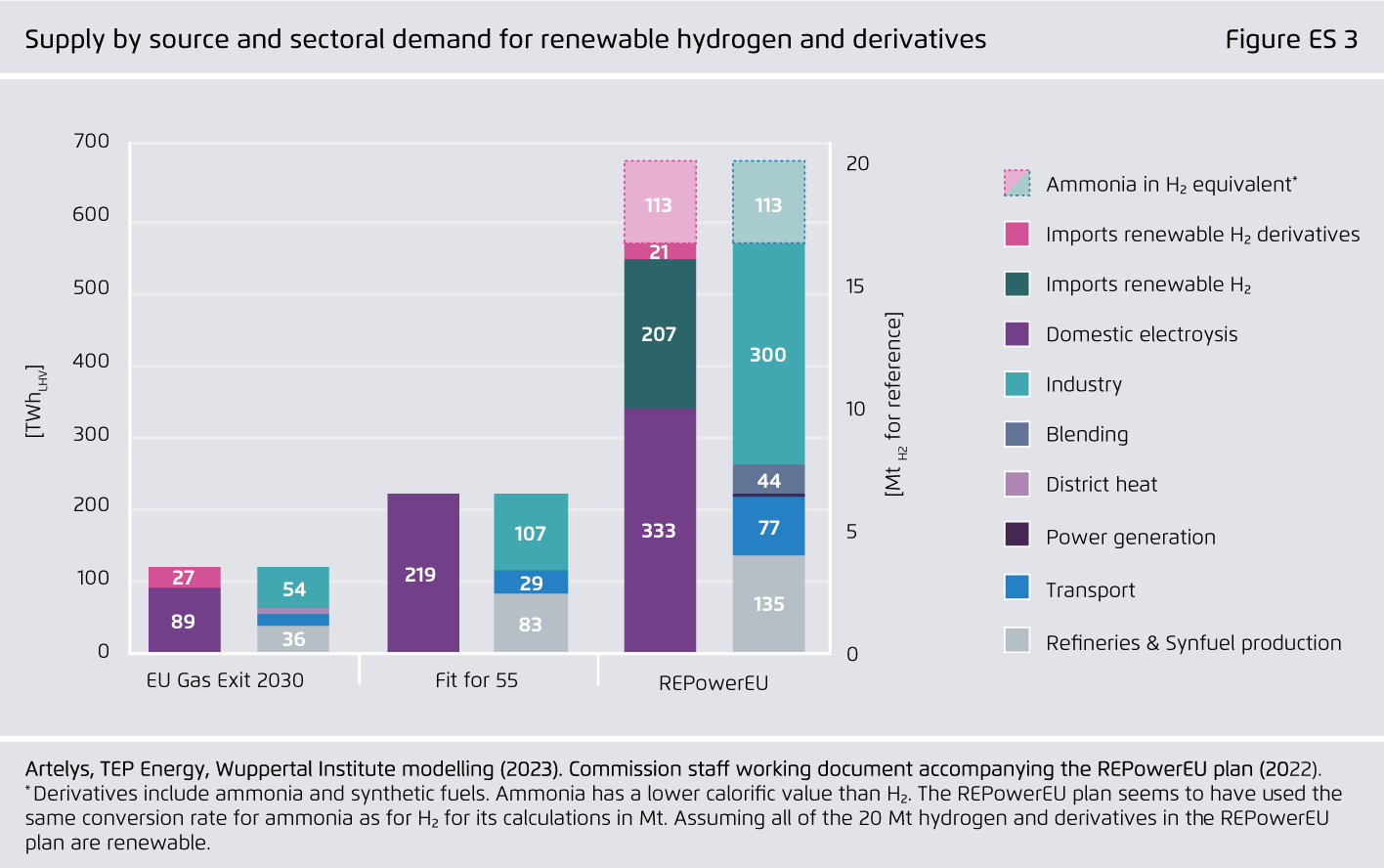
Under consideration of the Creative Commons license CC BY (attribution) the image may be further processed in any format or medium (also commercially, also in modified form), as long as the author is mentioned and a link to the license is given.
Scenario comparison – gas and H₂ derivatives in 2050
Figure ES 4 from Breaking free from fossil gas on page 12
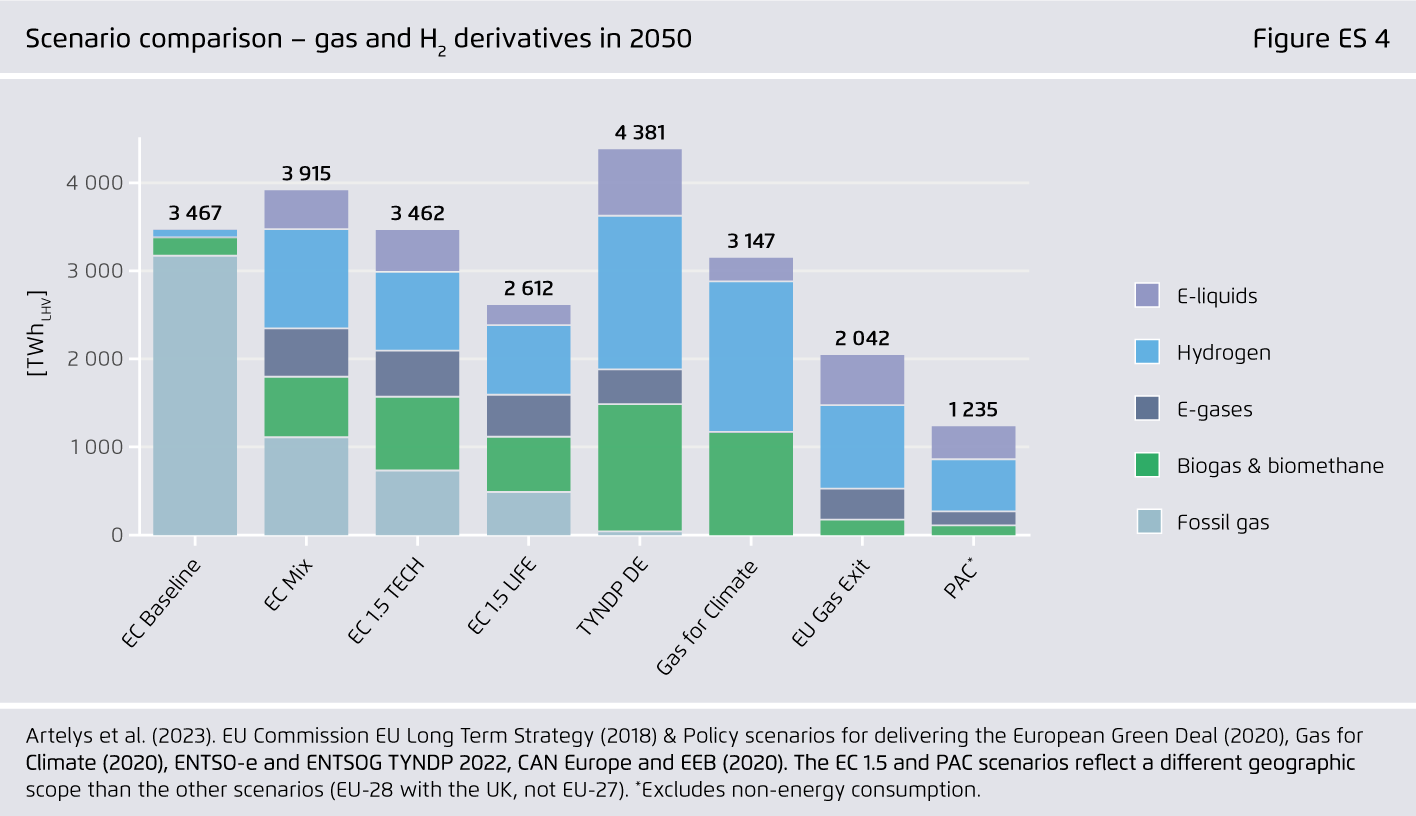
Under consideration of the Creative Commons license CC BY (attribution) the image may be further processed in any format or medium (also commercially, also in modified form), as long as the author is mentioned and a link to the license is given.
EU gas supply by source and import dependency in the EU Gas Exit Pathway
Figure ES 5 from Breaking free from fossil gas on page 13
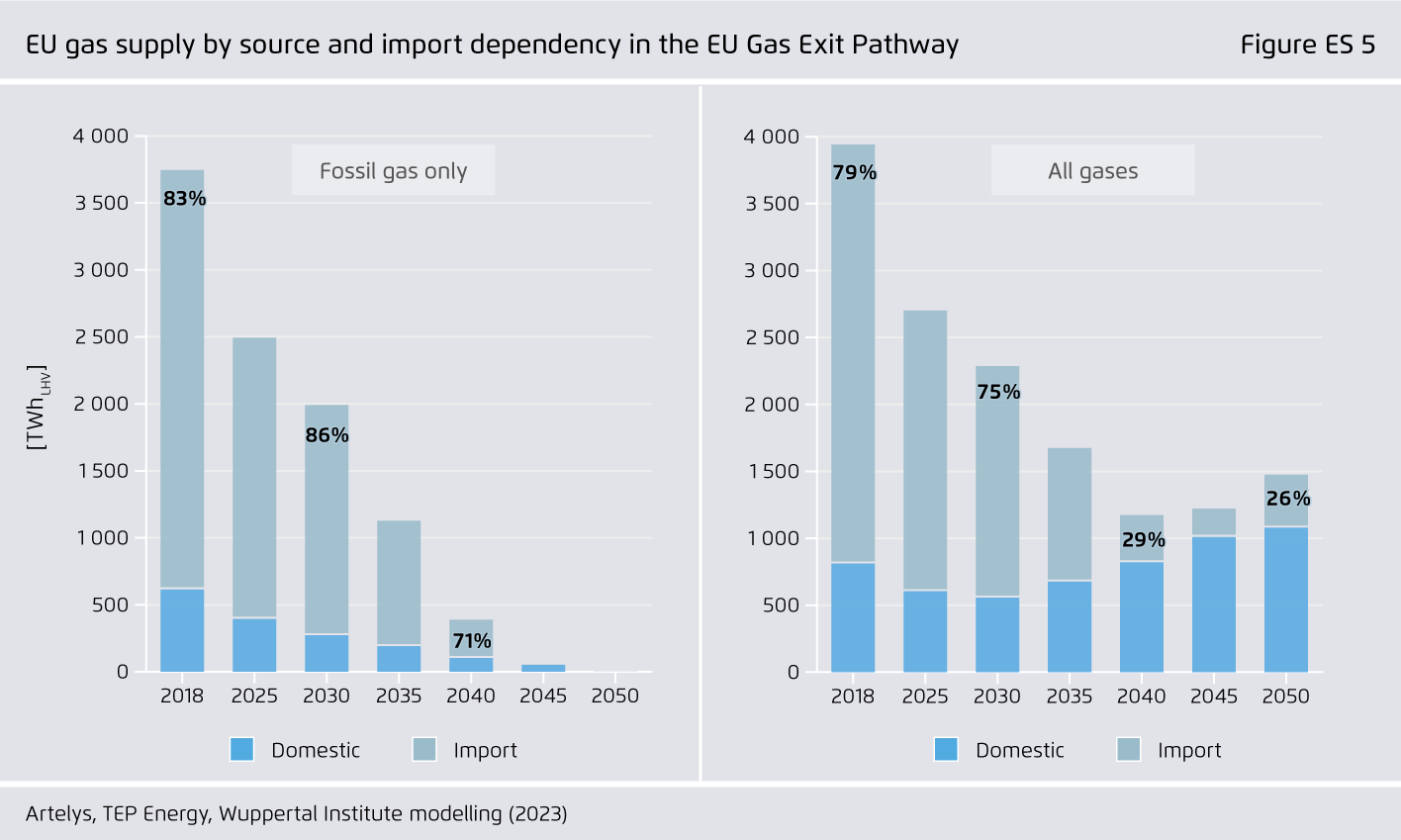
Under consideration of the Creative Commons license CC BY (attribution) the image may be further processed in any format or medium (also commercially, also in modified form), as long as the author is mentioned and a link to the license is given.
Annual average investment needs and EU fundings in 2021-2030 in diff erent regions
Figure ES 6 from Breaking free from fossil gas on page 15
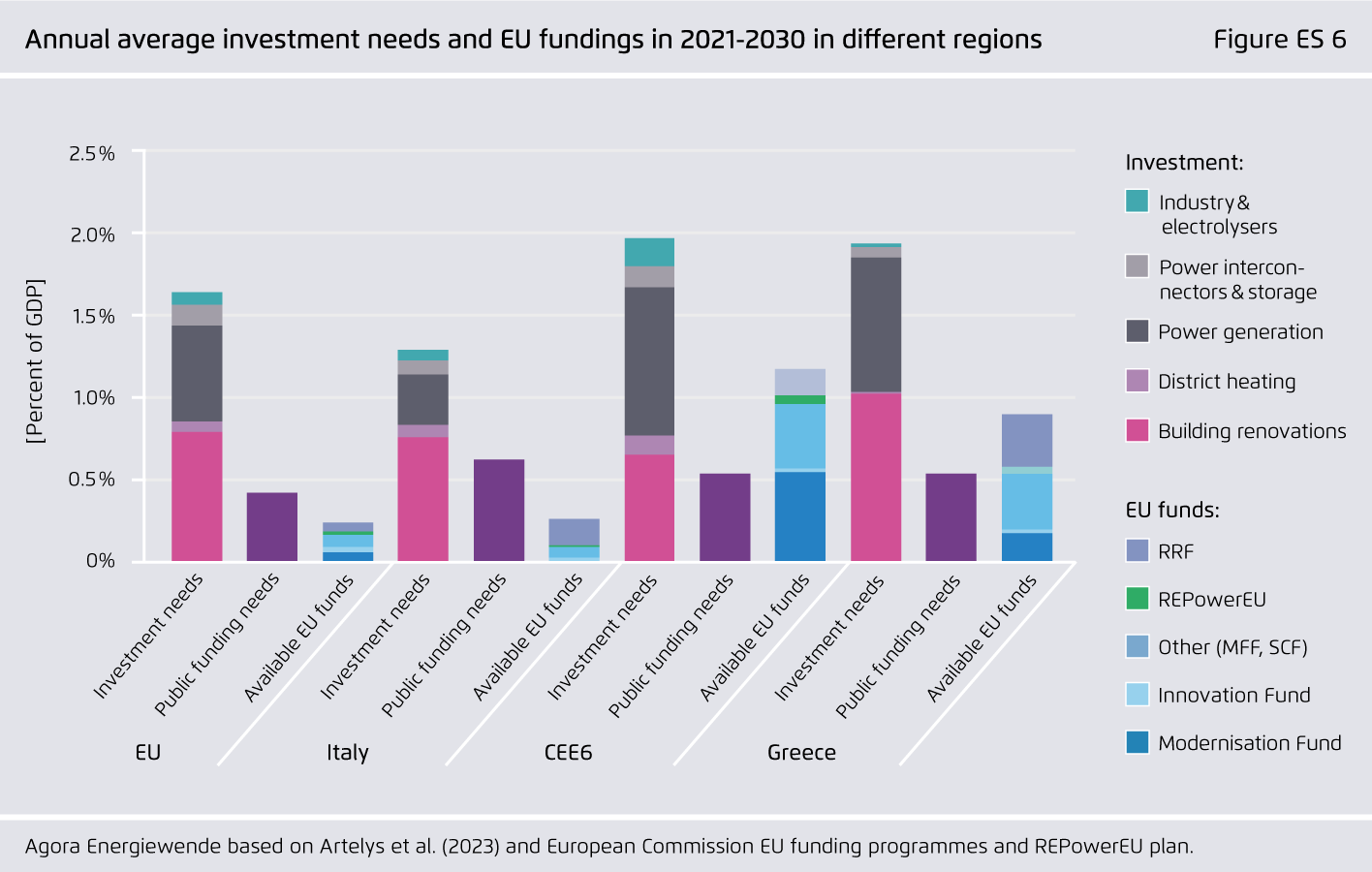
Under consideration of the Creative Commons license CC BY (attribution) the image may be further processed in any format or medium (also commercially, also in modified form), as long as the author is mentioned and a link to the license is given.
Evolution of total fossil gas consumption in the EU-27, 2018-2050
Figure 1 from Breaking free from fossil gas on page 20
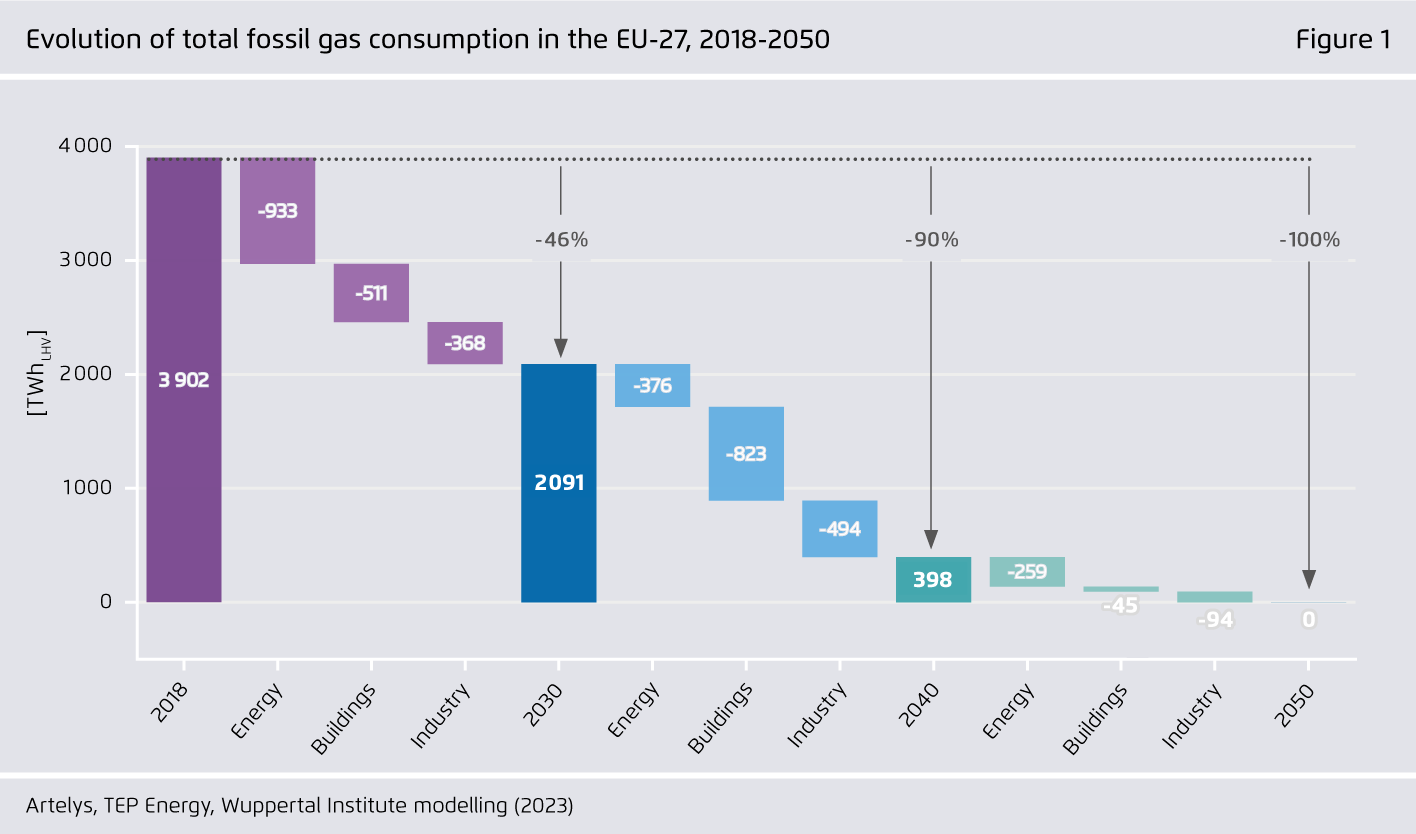
Under consideration of the Creative Commons license CC BY (attribution) the image may be further processed in any format or medium (also commercially, also in modified form), as long as the author is mentioned and a link to the license is given.
Fossil gas consumption in the EU by sector, 1990–2022
Figure 2 from Breaking free from fossil gas on page 21
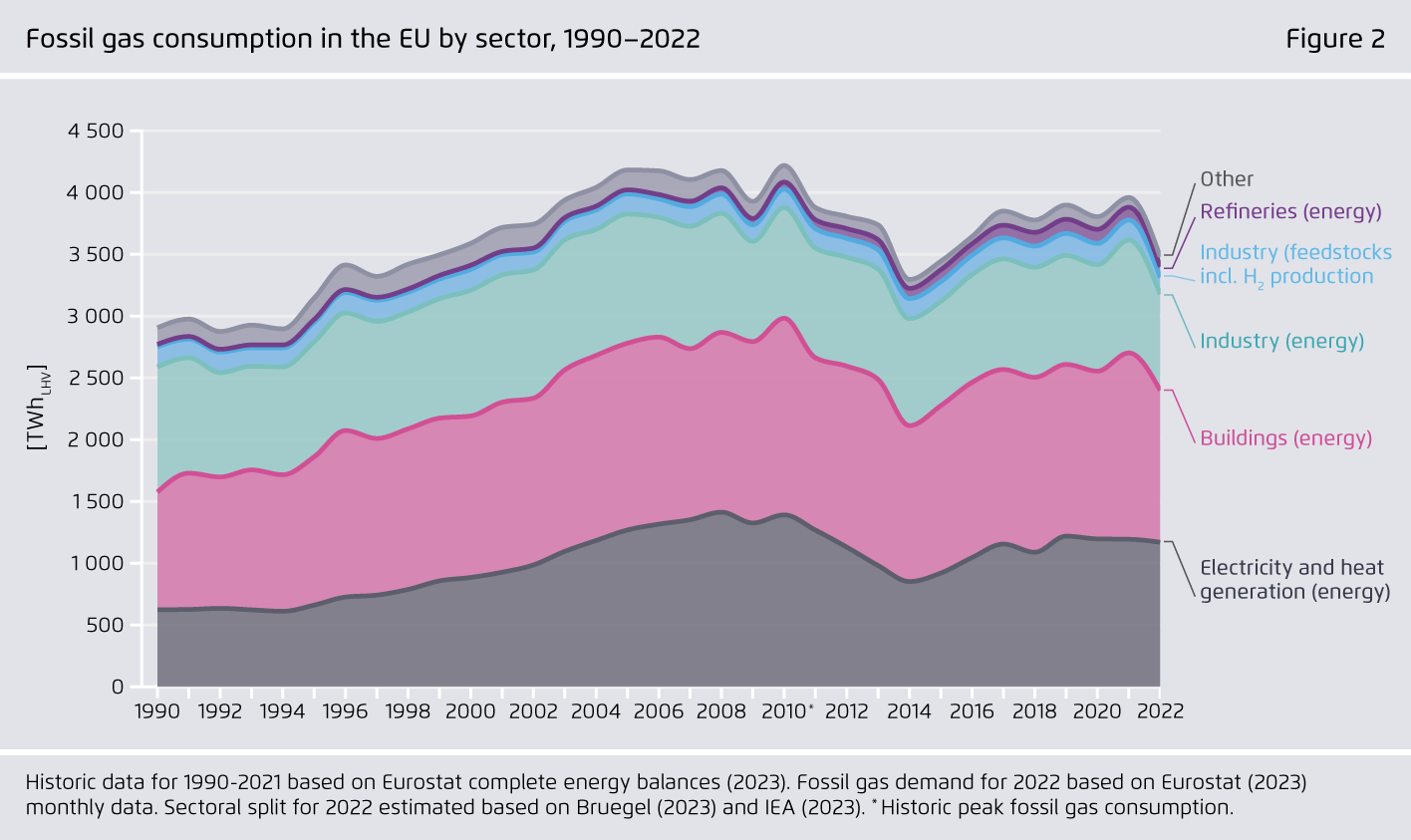
Under consideration of the Creative Commons license CC BY (attribution) the image may be further processed in any format or medium (also commercially, also in modified form), as long as the author is mentioned and a link to the license is given.
Fossil gas consumption in the EU by sector in 2018
Figure 3 from Breaking free from fossil gas on page 22
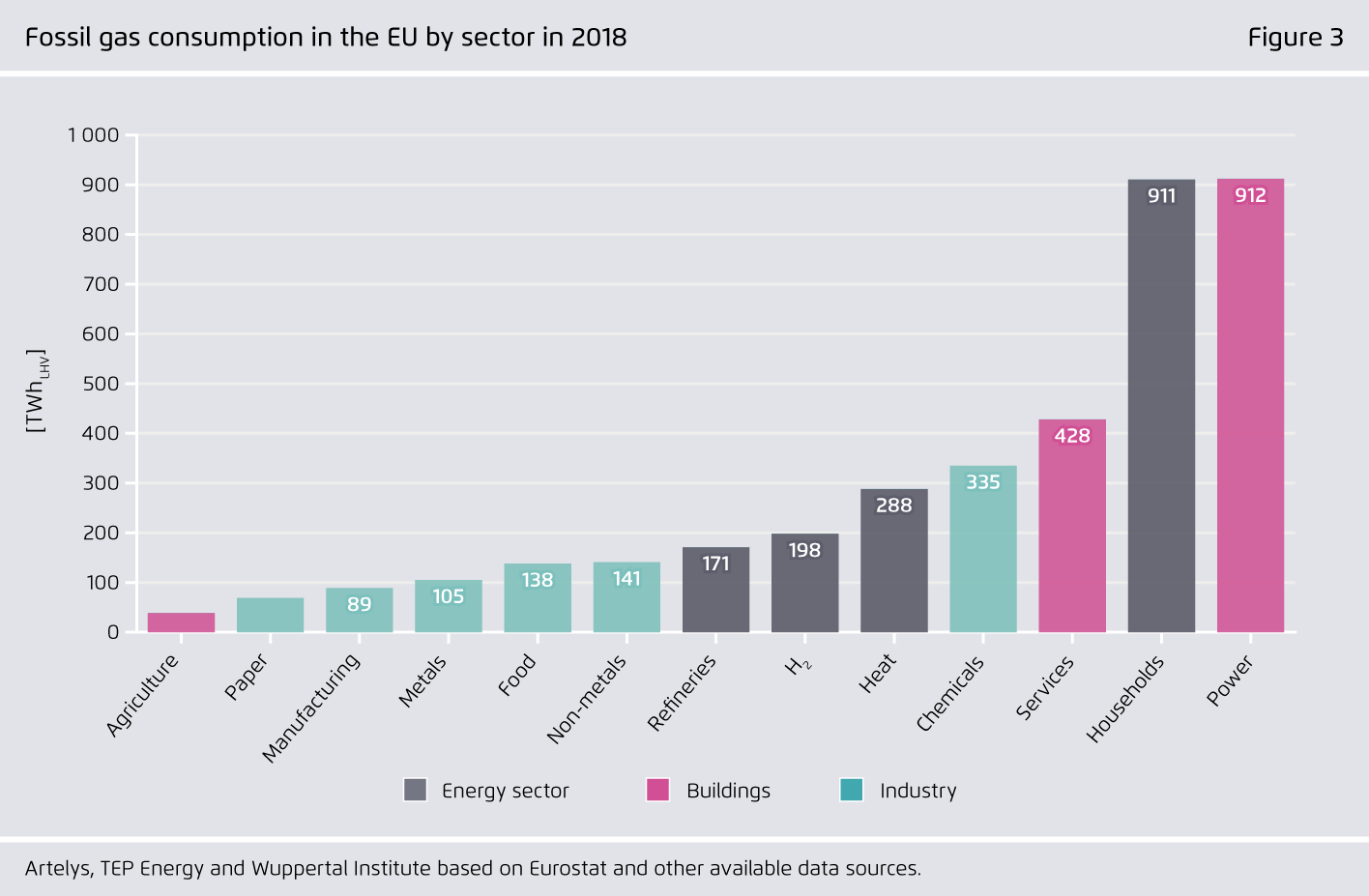
Under consideration of the Creative Commons license CC BY (attribution) the image may be further processed in any format or medium (also commercially, also in modified form), as long as the author is mentioned and a link to the license is given.
Overview of process heating in industry in 2018 by energy source and temperature level
Figure 4 from Breaking free from fossil gas on page 23
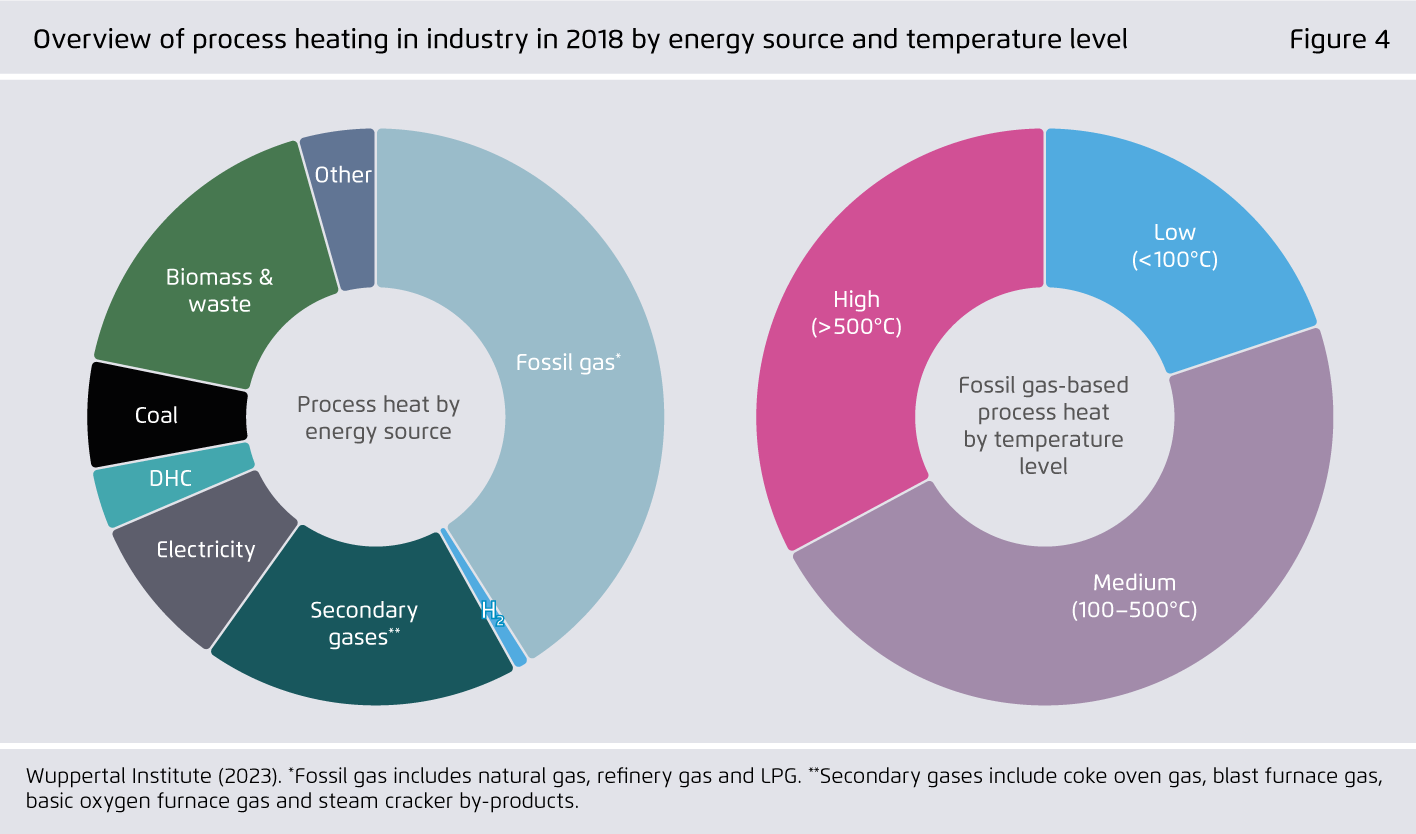
Under consideration of the Creative Commons license CC BY (attribution) the image may be further processed in any format or medium (also commercially, also in modified form), as long as the author is mentioned and a link to the license is given.
Evolution of total fossil gas consumption in the energy sector in the EU-27, 2018-2050
Figure 5 from Breaking free from fossil gas on page 24
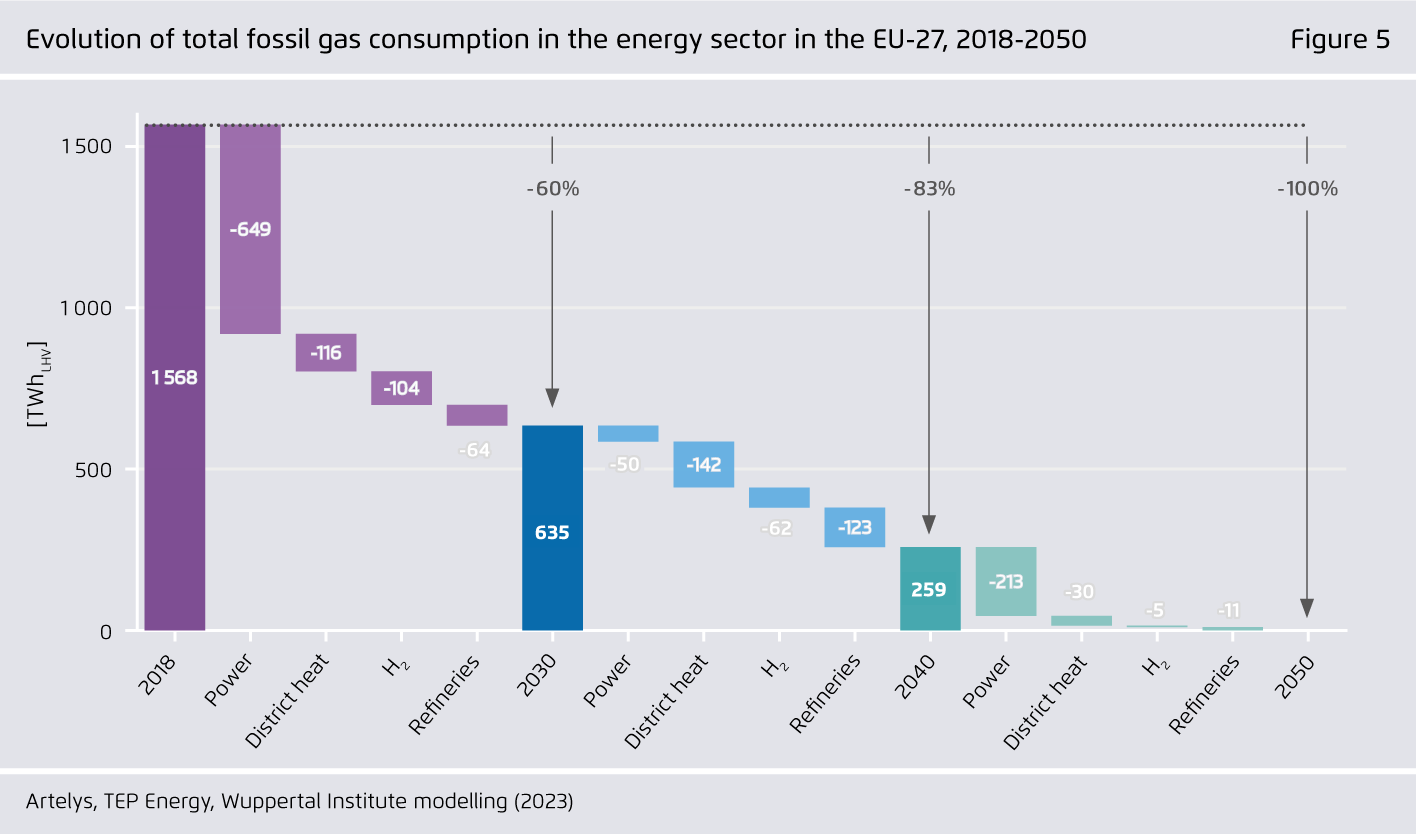
Under consideration of the Creative Commons license CC BY (attribution) the image may be further processed in any format or medium (also commercially, also in modified form), as long as the author is mentioned and a link to the license is given.
Residual fossil and renewable methane consumption in the EU-27 in 2040
Figure 6 from Breaking free from fossil gas on page 25
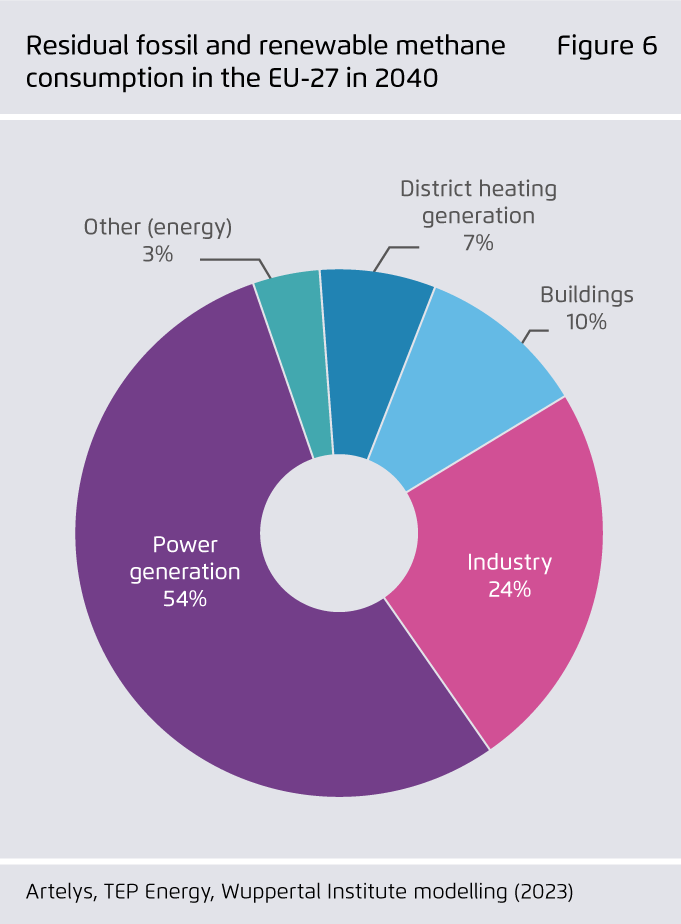
Under consideration of the Creative Commons license CC BY (attribution) the image may be further processed in any format or medium (also commercially, also in modified form), as long as the author is mentioned and a link to the license is given.
Net-electricity generation in the EU Gas Exit Pathway
Figure 7 from Breaking free from fossil gas on page 26
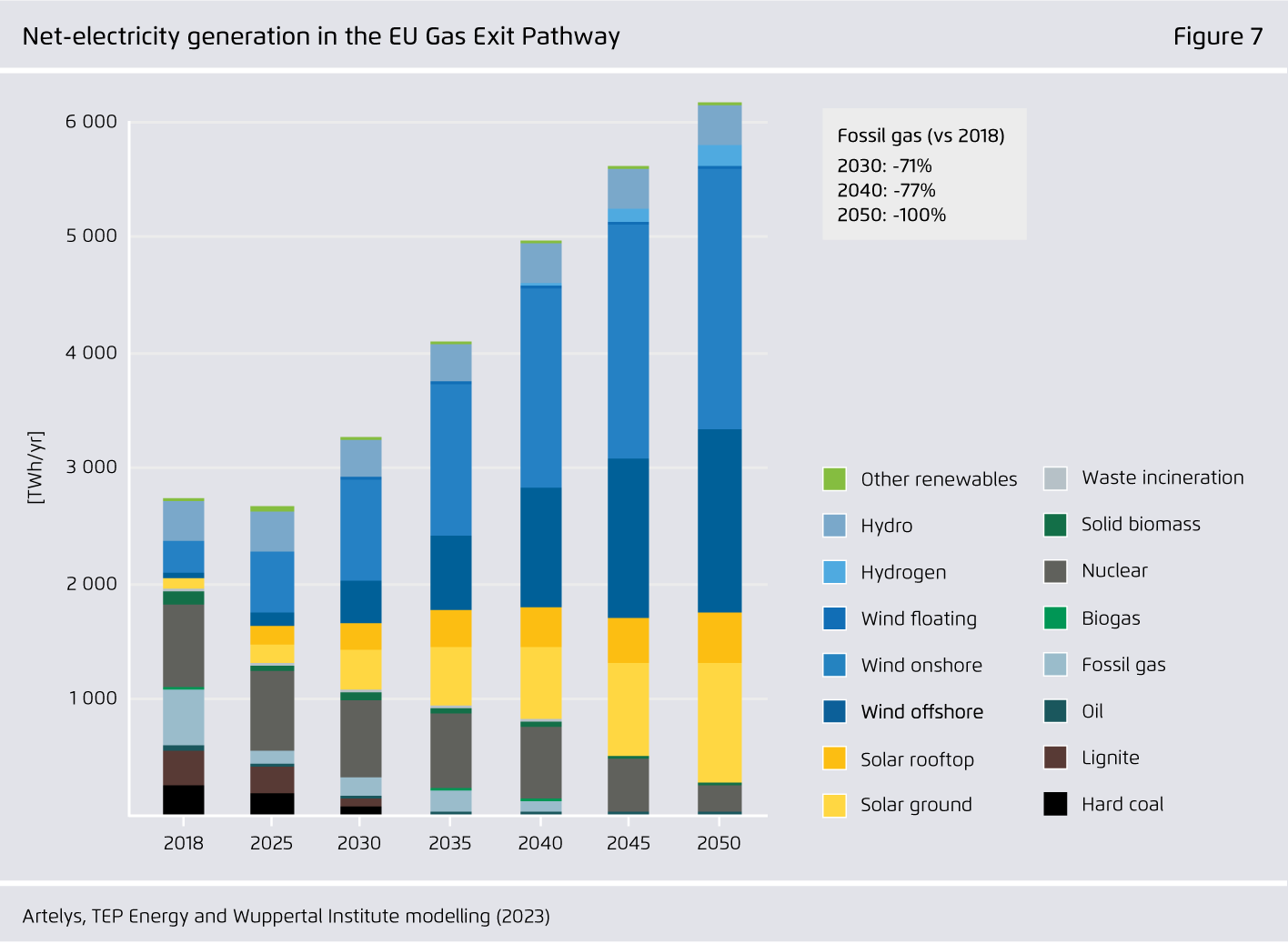
Under consideration of the Creative Commons license CC BY (attribution) the image may be further processed in any format or medium (also commercially, also in modified form), as long as the author is mentioned and a link to the license is given.
Energy consumption for district heat generation, EU-27
Figure 8 from Breaking free from fossil gas on page 27
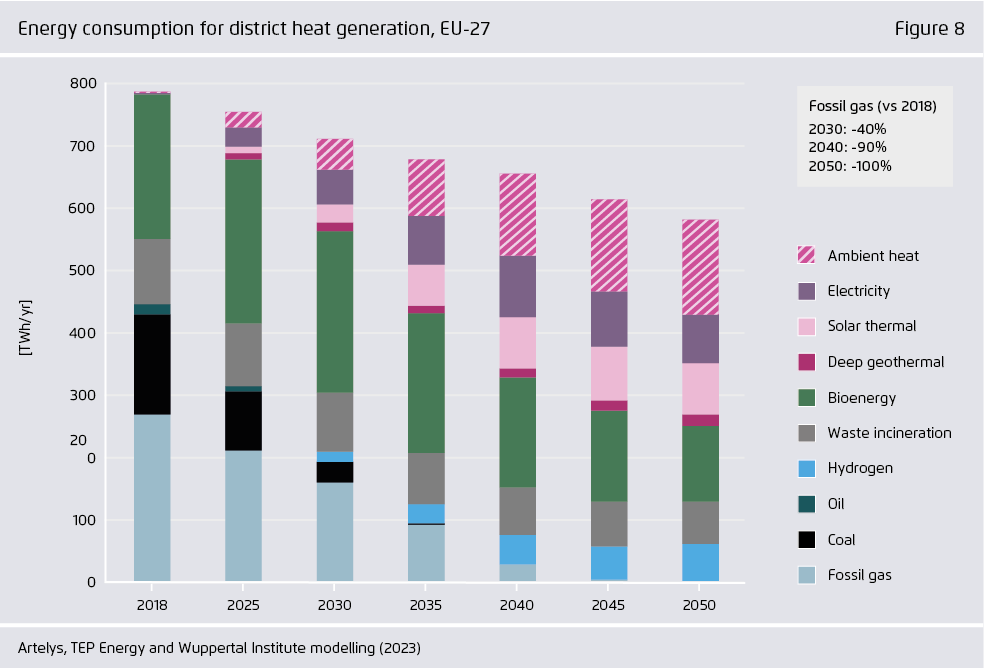
Under consideration of the Creative Commons license CC BY (attribution) the image may be further processed in any format or medium (also commercially, also in modified form), as long as the author is mentioned and a link to the license is given.
Energy and non-energy consumption for refineries and synfuels production, EU-27
Figure 9 from Breaking free from fossil gas on page 27
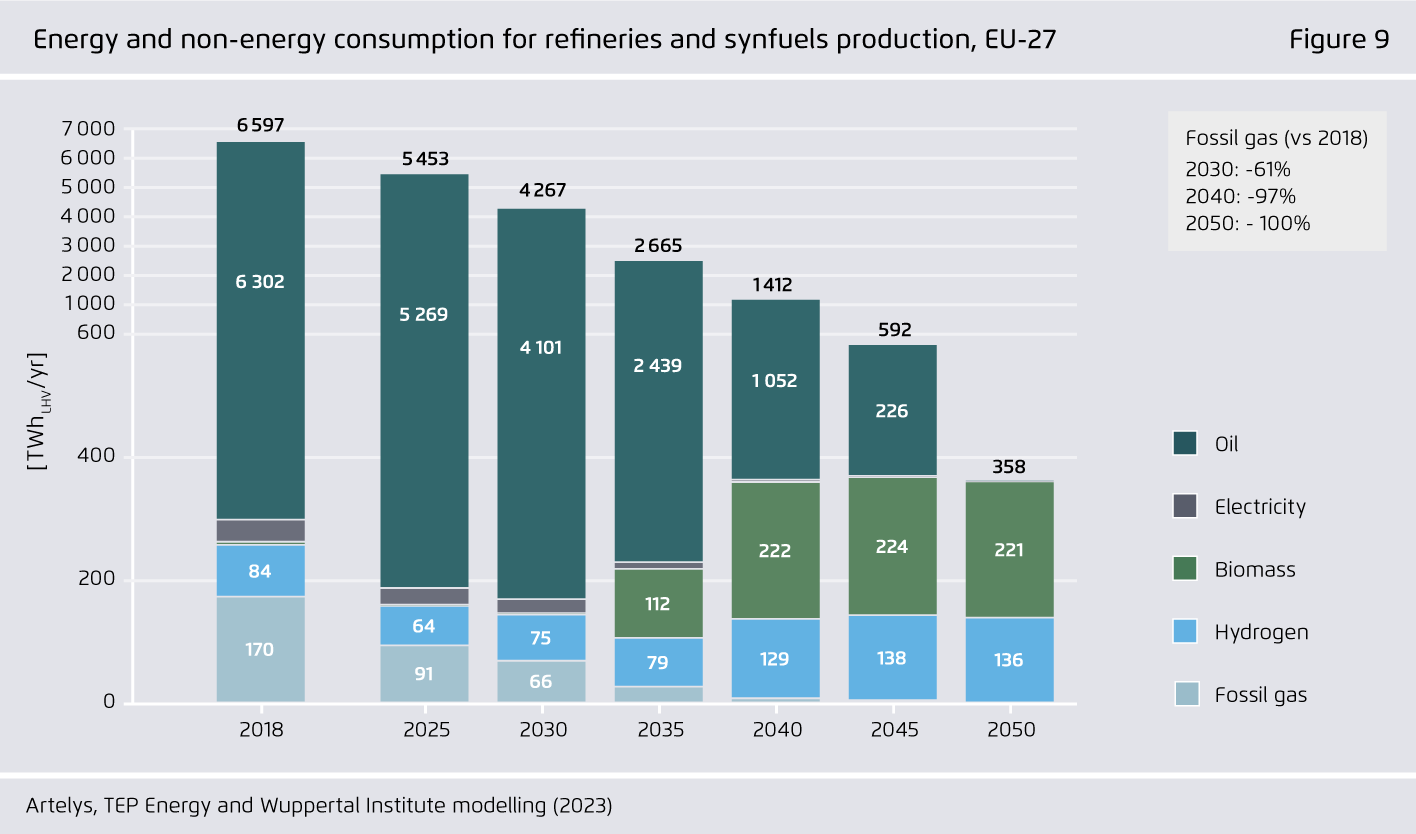
Under consideration of the Creative Commons license CC BY (attribution) the image may be further processed in any format or medium (also commercially, also in modified form), as long as the author is mentioned and a link to the license is given.
Energy consumption for hydrogen production, EU-27
Figure 10 from Breaking free from fossil gas on page 28
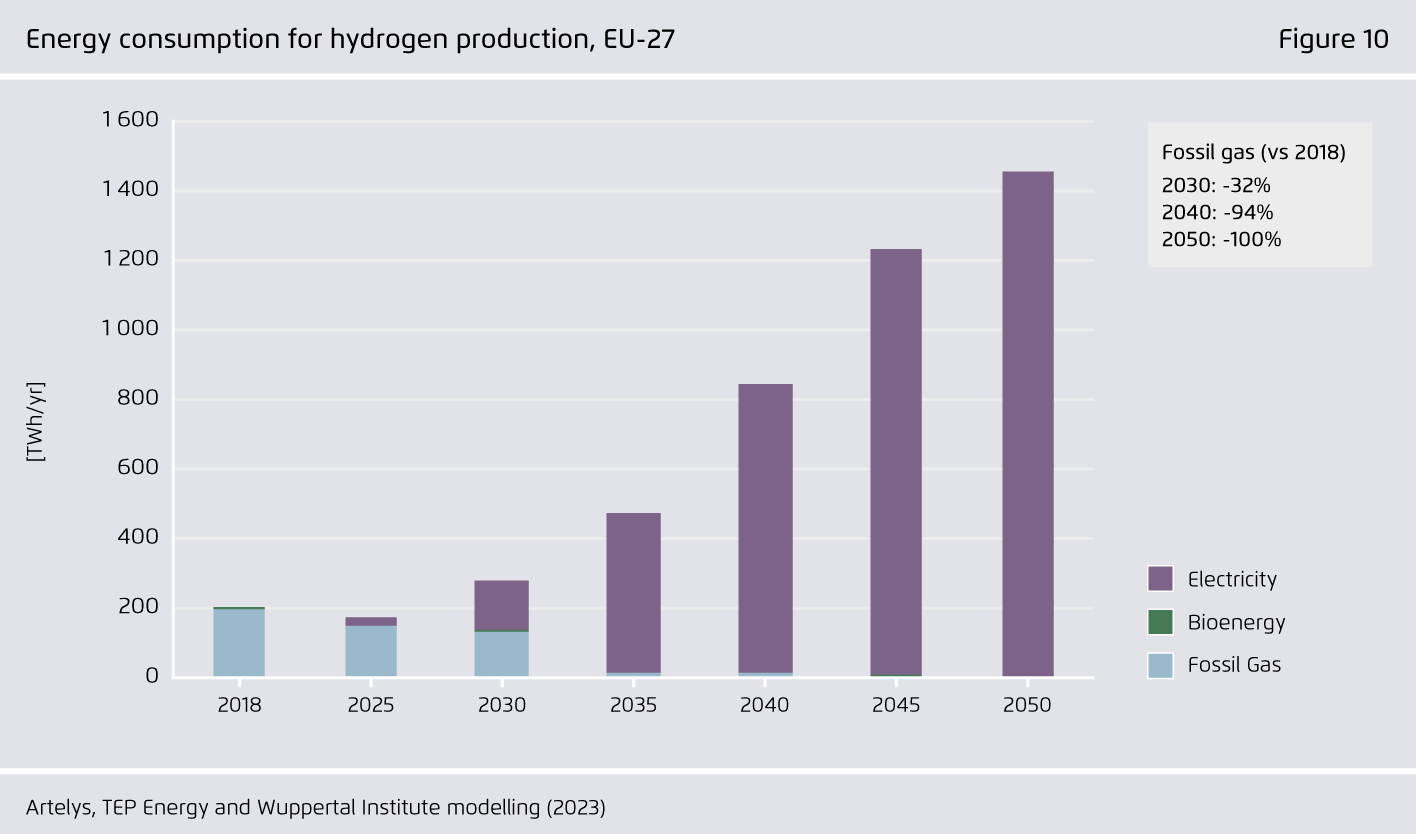
Under consideration of the Creative Commons license CC BY (attribution) the image may be further processed in any format or medium (also commercially, also in modified form), as long as the author is mentioned and a link to the license is given.
Final energy consumption in buildings, EU-27
Figure 11 from Breaking free from fossil gas on page 29
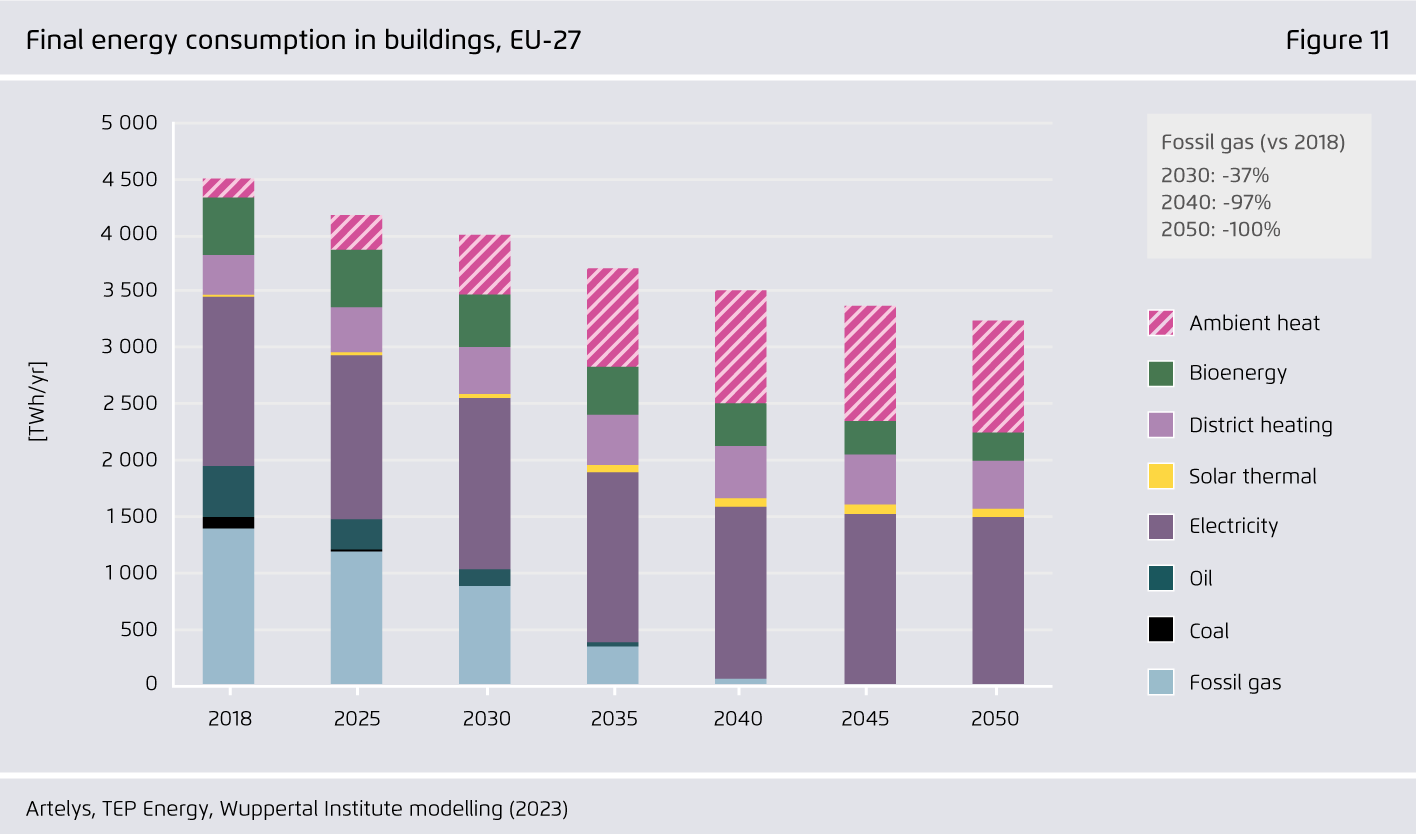
Under consideration of the Creative Commons license CC BY (attribution) the image may be further processed in any format or medium (also commercially, also in modified form), as long as the author is mentioned and a link to the license is given.
Scenario comparison – total (fossil and renewable) gas consumption in buildings
Figure 12 from Breaking free from fossil gas on page 30
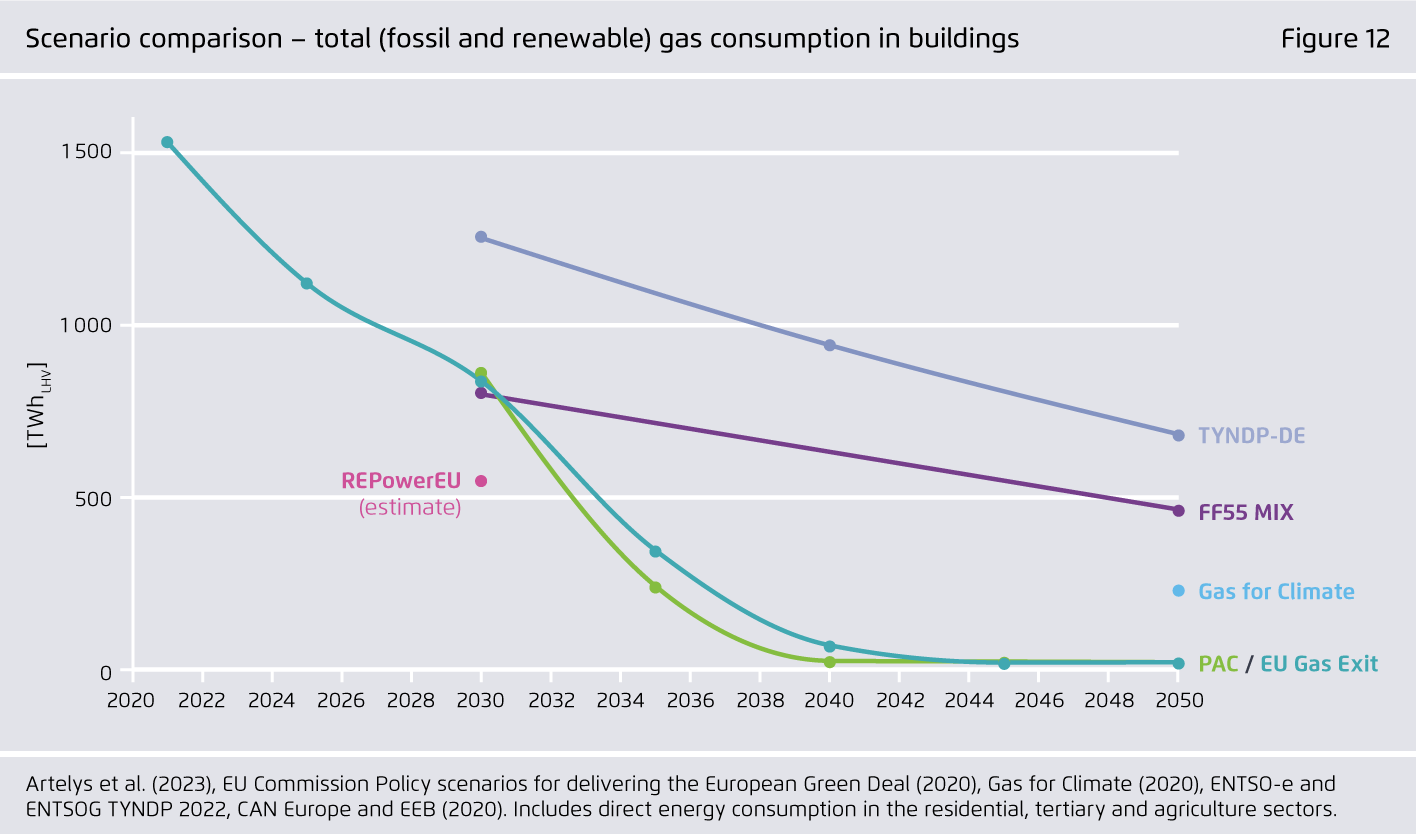
Under consideration of the Creative Commons license CC BY (attribution) the image may be further processed in any format or medium (also commercially, also in modified form), as long as the author is mentioned and a link to the license is given.
Evolution of total fossil gas consumption in the industry sector in the EU-27, 2018-2050
Figure 13 from Breaking free from fossil gas on page 33
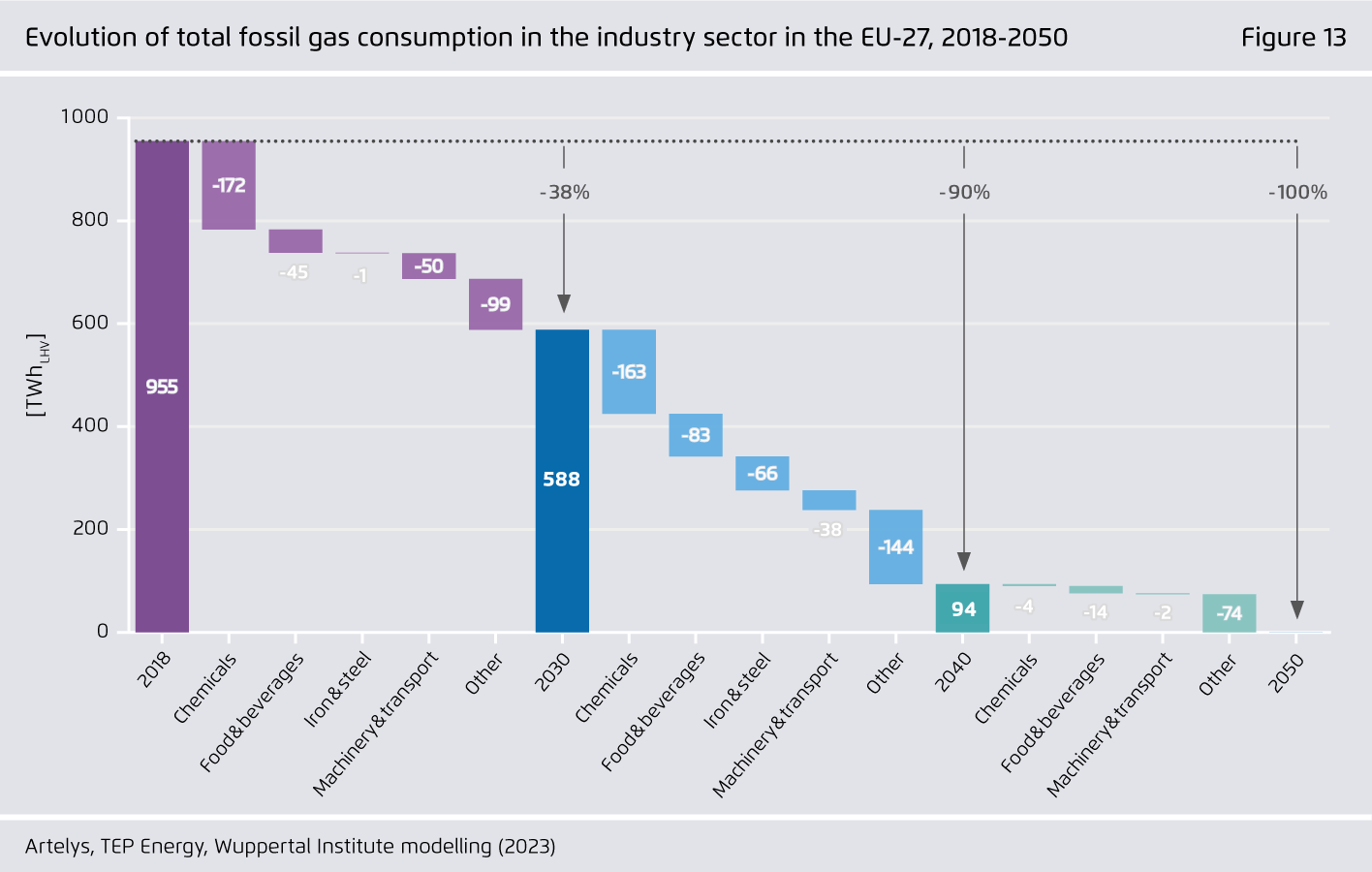
Under consideration of the Creative Commons license CC BY (attribution) the image may be further processed in any format or medium (also commercially, also in modified form), as long as the author is mentioned and a link to the license is given.
Achievable temperature ranges and electricity requirements of electricity-based technology options for climate-neutral heat
Figure 14 from Breaking free from fossil gas on page 34
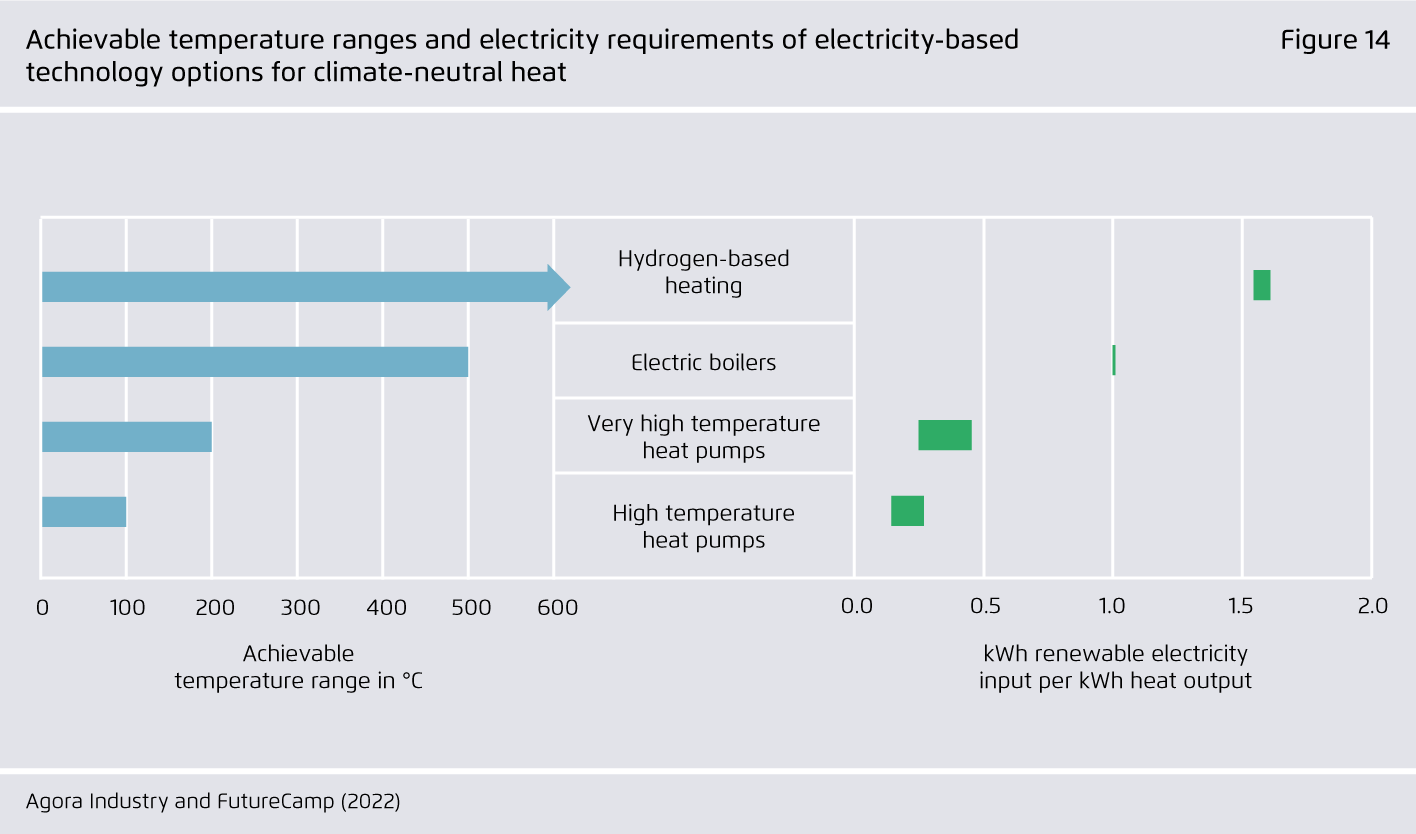
Under consideration of the Creative Commons license CC BY (attribution) the image may be further processed in any format or medium (also commercially, also in modified form), as long as the author is mentioned and a link to the license is given.
Evolution of fossil-gas* consumption in the industry sector by sub-sector and heat type, EU-27
Figure 15 from Breaking free from fossil gas on page 35
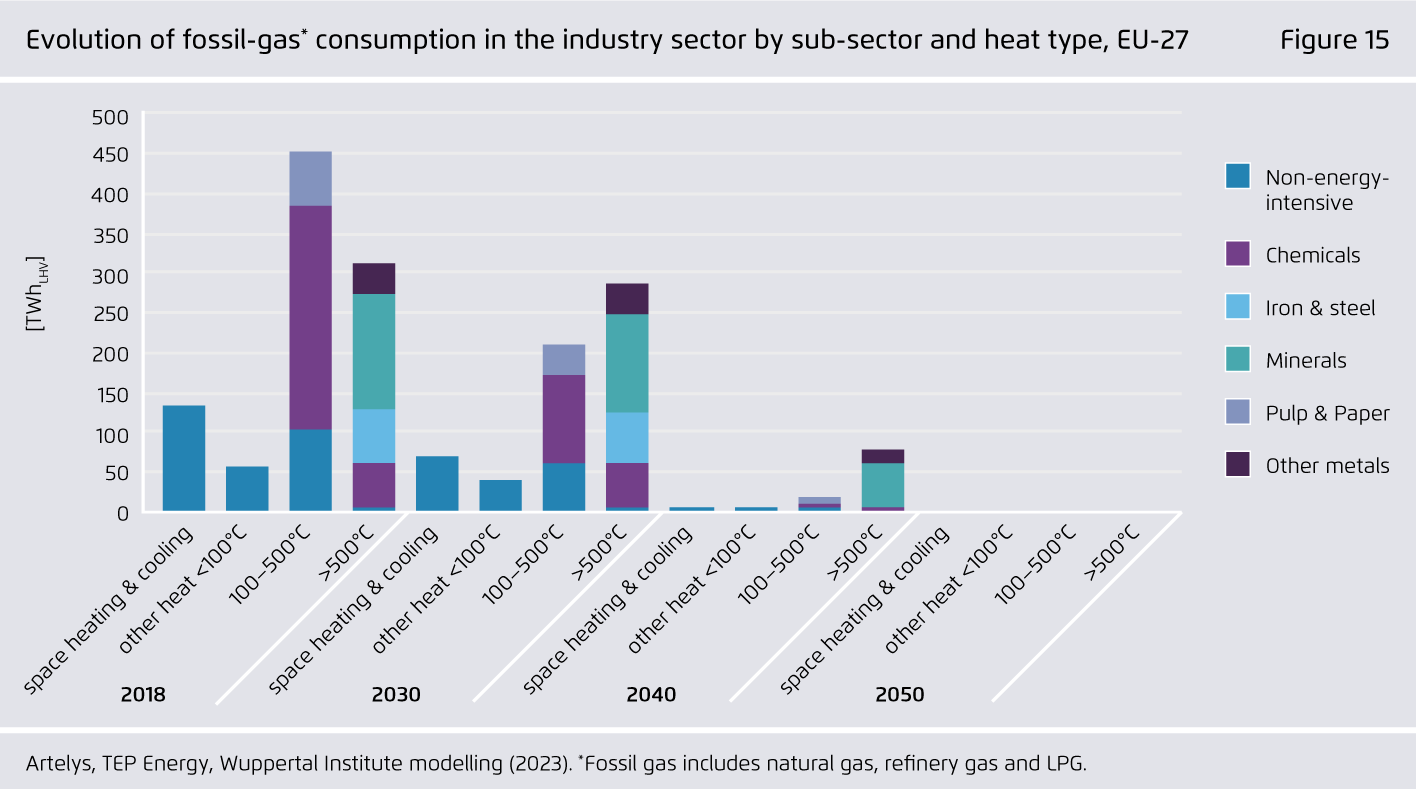
Under consideration of the Creative Commons license CC BY (attribution) the image may be further processed in any format or medium (also commercially, also in modified form), as long as the author is mentioned and a link to the license is given.
Final energy consumption in industry, EU-27
Figure 16 from Breaking free from fossil gas on page 36
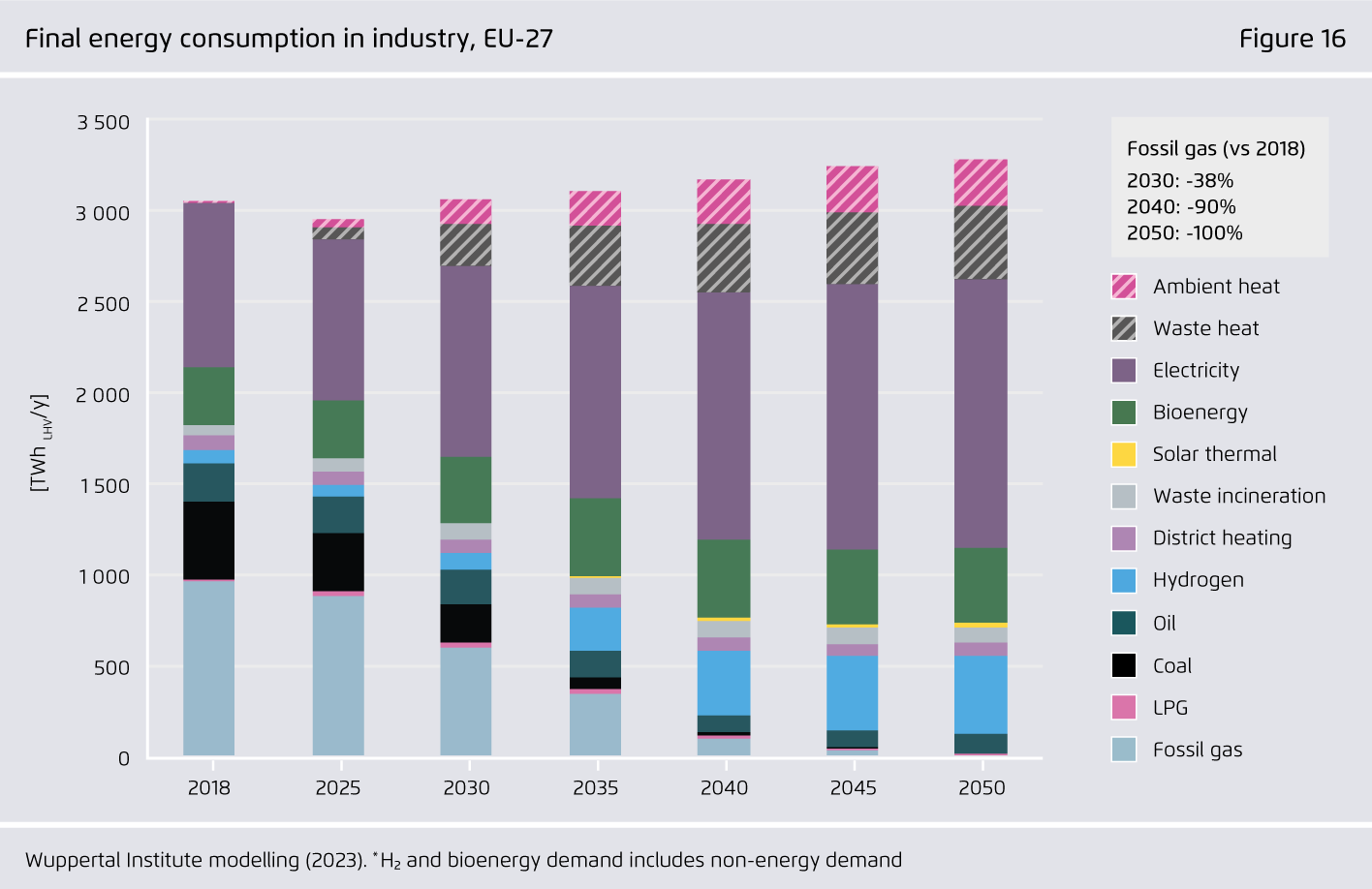
Under consideration of the Creative Commons license CC BY (attribution) the image may be further processed in any format or medium (also commercially, also in modified form), as long as the author is mentioned and a link to the license is given.
Timeline of the various milestones and processes
Figure 17 from Breaking free from fossil gas on page 38
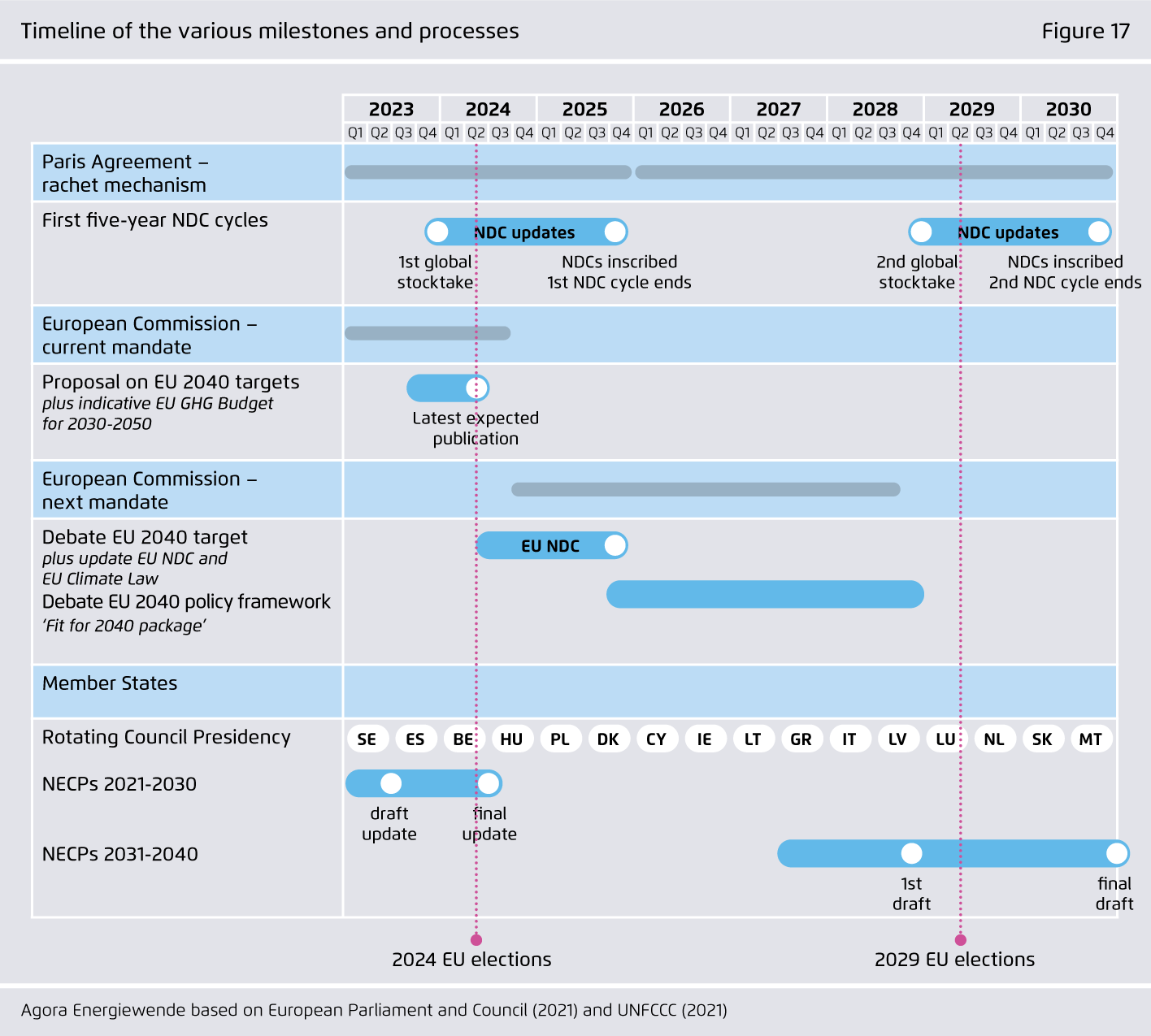
Under consideration of the Creative Commons license CC BY (attribution) the image may be further processed in any format or medium (also commercially, also in modified form), as long as the author is mentioned and a link to the license is given.
GHG emissions by sector
Figure 18 from Breaking free from fossil gas on page 39
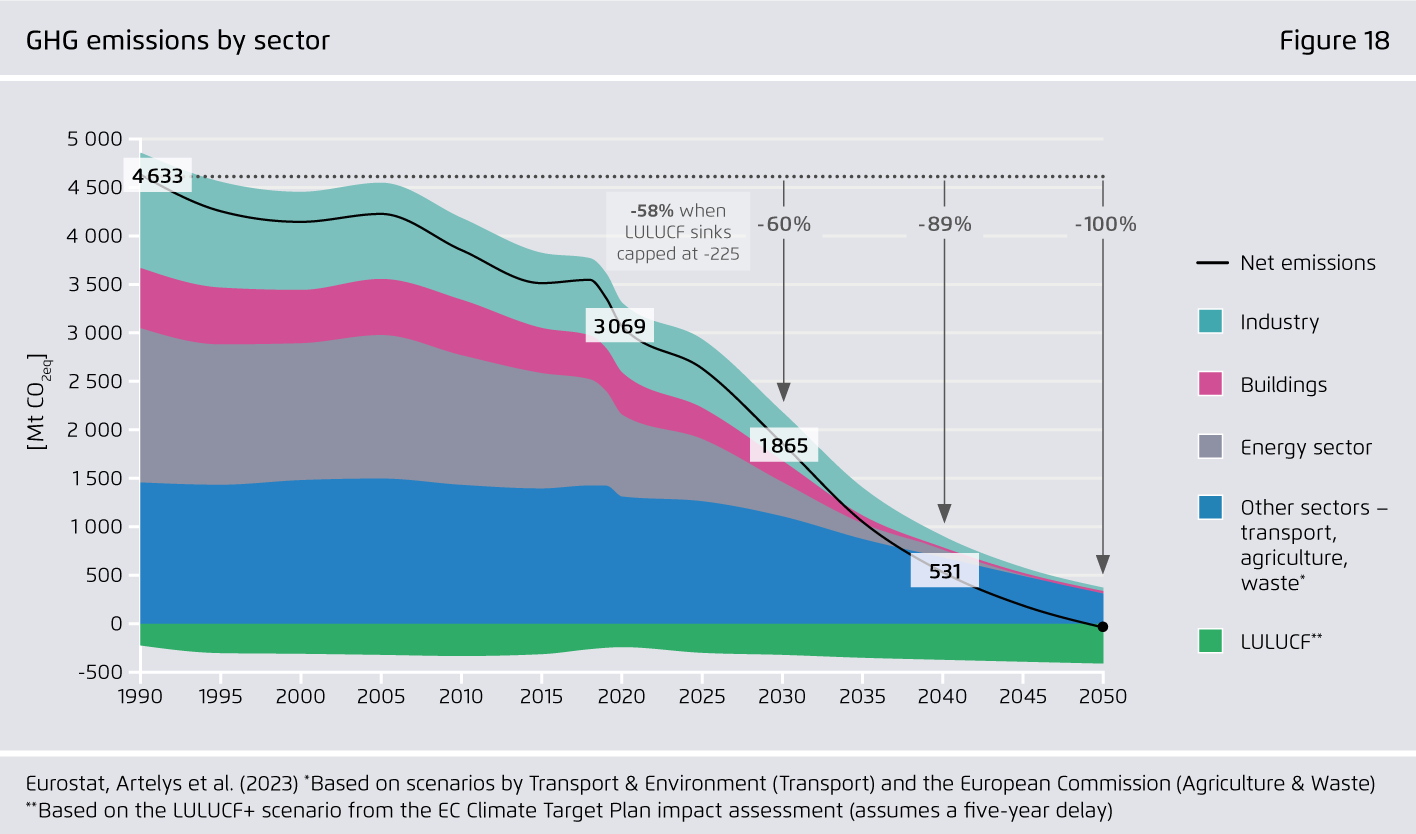
Under consideration of the Creative Commons license CC BY (attribution) the image may be further processed in any format or medium (also commercially, also in modified form), as long as the author is mentioned and a link to the license is given.
Reduction of fossil gas consumption in the EU Gas Exit Pathway, Fit for 55 package and REPowerEU plan
Figure 19 from Breaking free from fossil gas on page 40
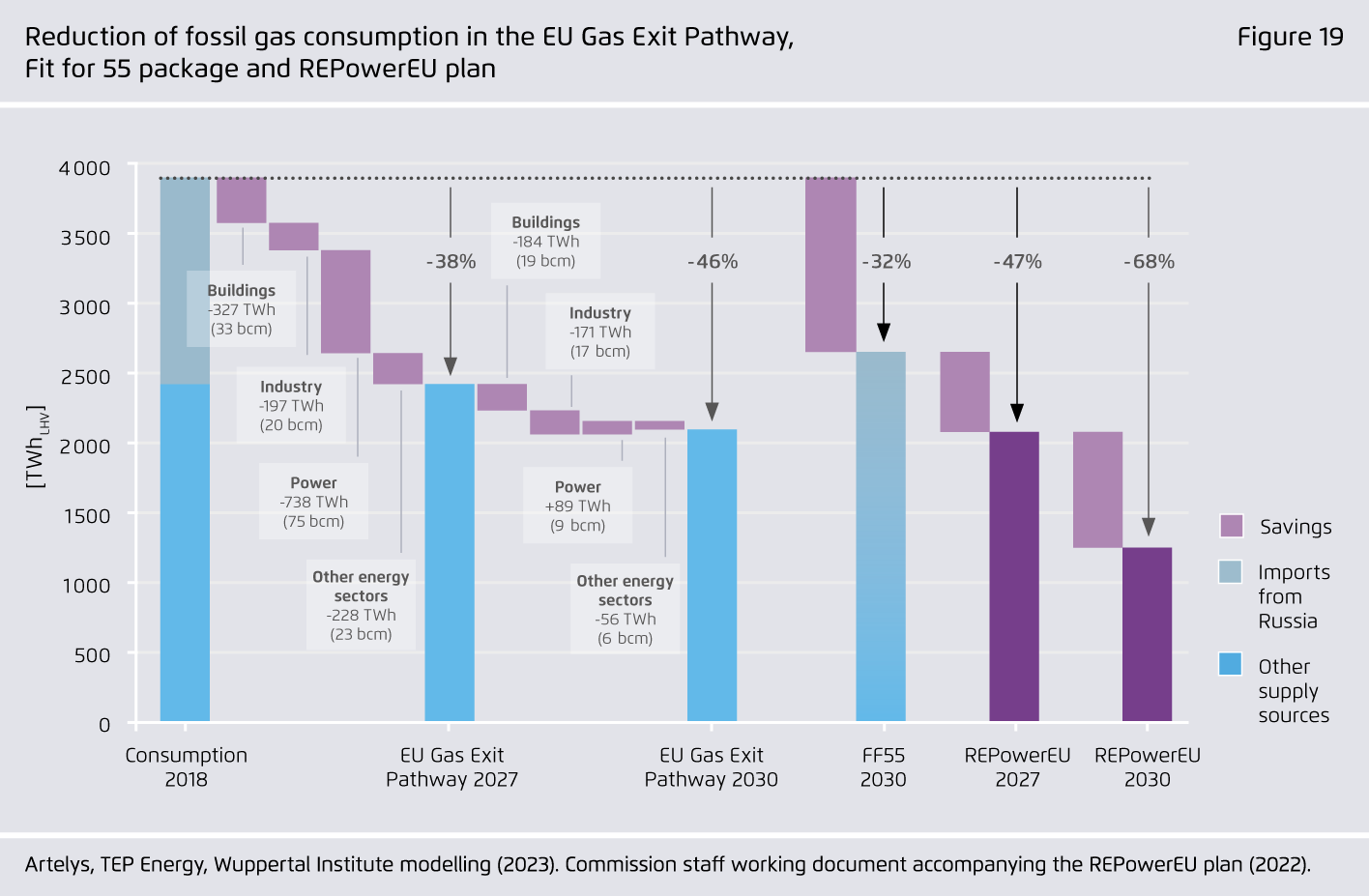
Under consideration of the Creative Commons license CC BY (attribution) the image may be further processed in any format or medium (also commercially, also in modified form), as long as the author is mentioned and a link to the license is given.
GHG emissions reductions in kg of CO₂eq when using 1 MWh* of renewable electricity to substitute fossil fuels in diff erent applications
Figure 20 from Breaking free from fossil gas on page 41
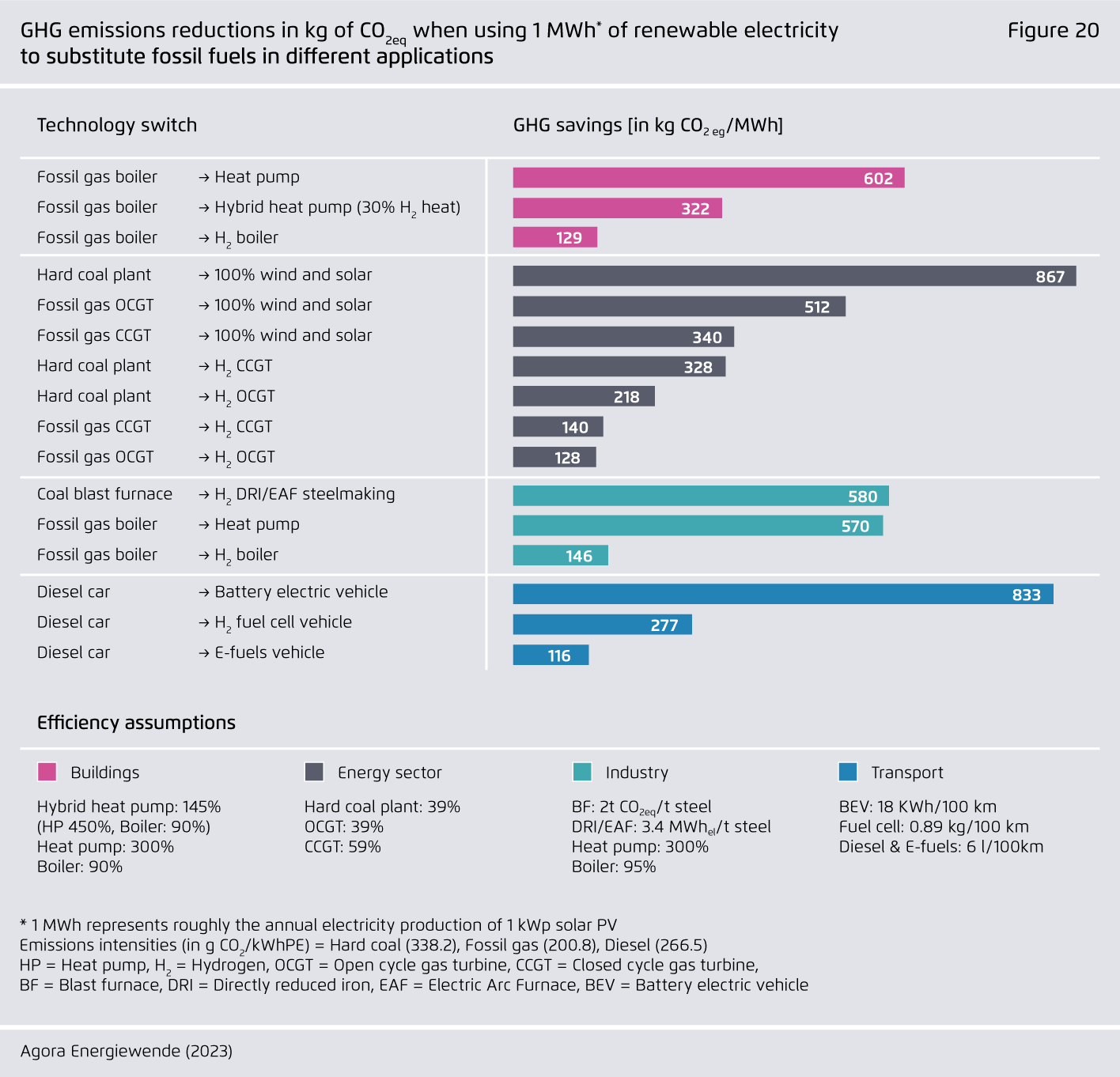
Under consideration of the Creative Commons license CC BY (attribution) the image may be further processed in any format or medium (also commercially, also in modified form), as long as the author is mentioned and a link to the license is given.
Net electricity generation by energy source in the EU Gas Exit scenario, Fit for 55 package and REPowerEU plan
Figure 21 from Breaking free from fossil gas on page 42
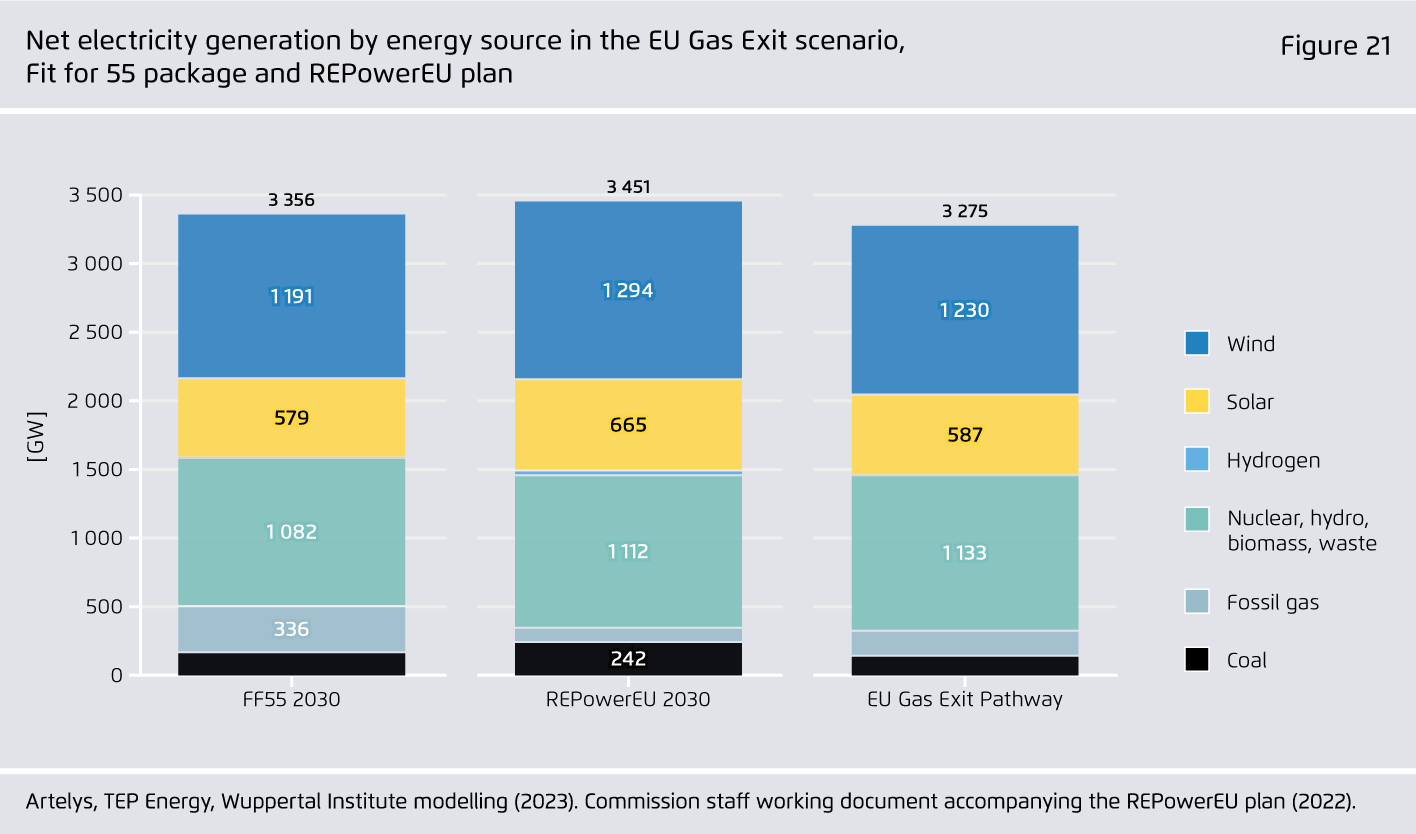
Under consideration of the Creative Commons license CC BY (attribution) the image may be further processed in any format or medium (also commercially, also in modified form), as long as the author is mentioned and a link to the license is given.
Installed capacity for solar and wind power in the EU Gas Exit scenario, Fit for 55 package and REPowerEU plan
Figure 22 from Breaking free from fossil gas on page 43
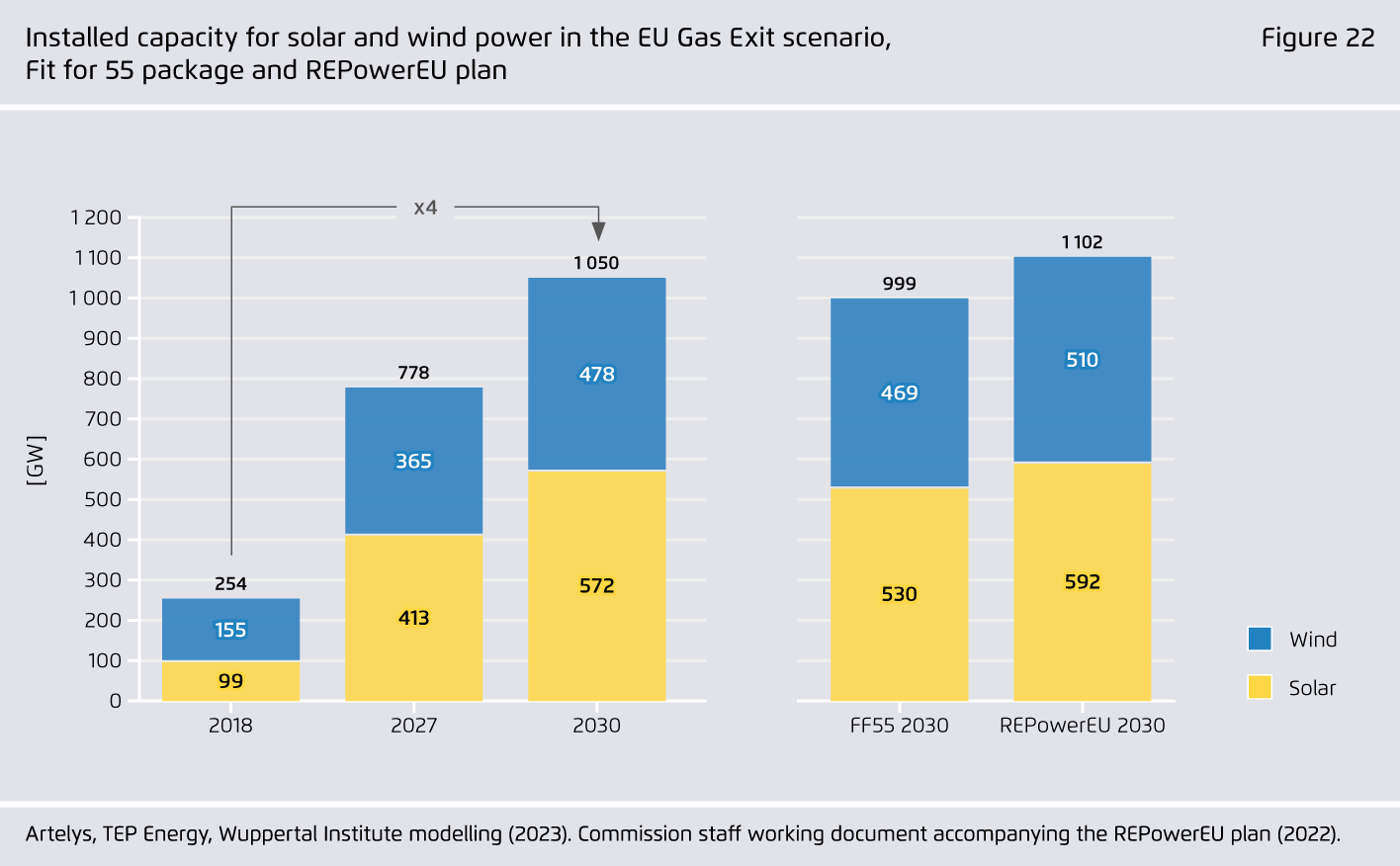
Under consideration of the Creative Commons license CC BY (attribution) the image may be further processed in any format or medium (also commercially, also in modified form), as long as the author is mentioned and a link to the license is given.
Energy demand in the EU Gas Exit Pathway and in the REPowerEU plan by type in 2030
Figure 23 from Breaking free from fossil gas on page 44
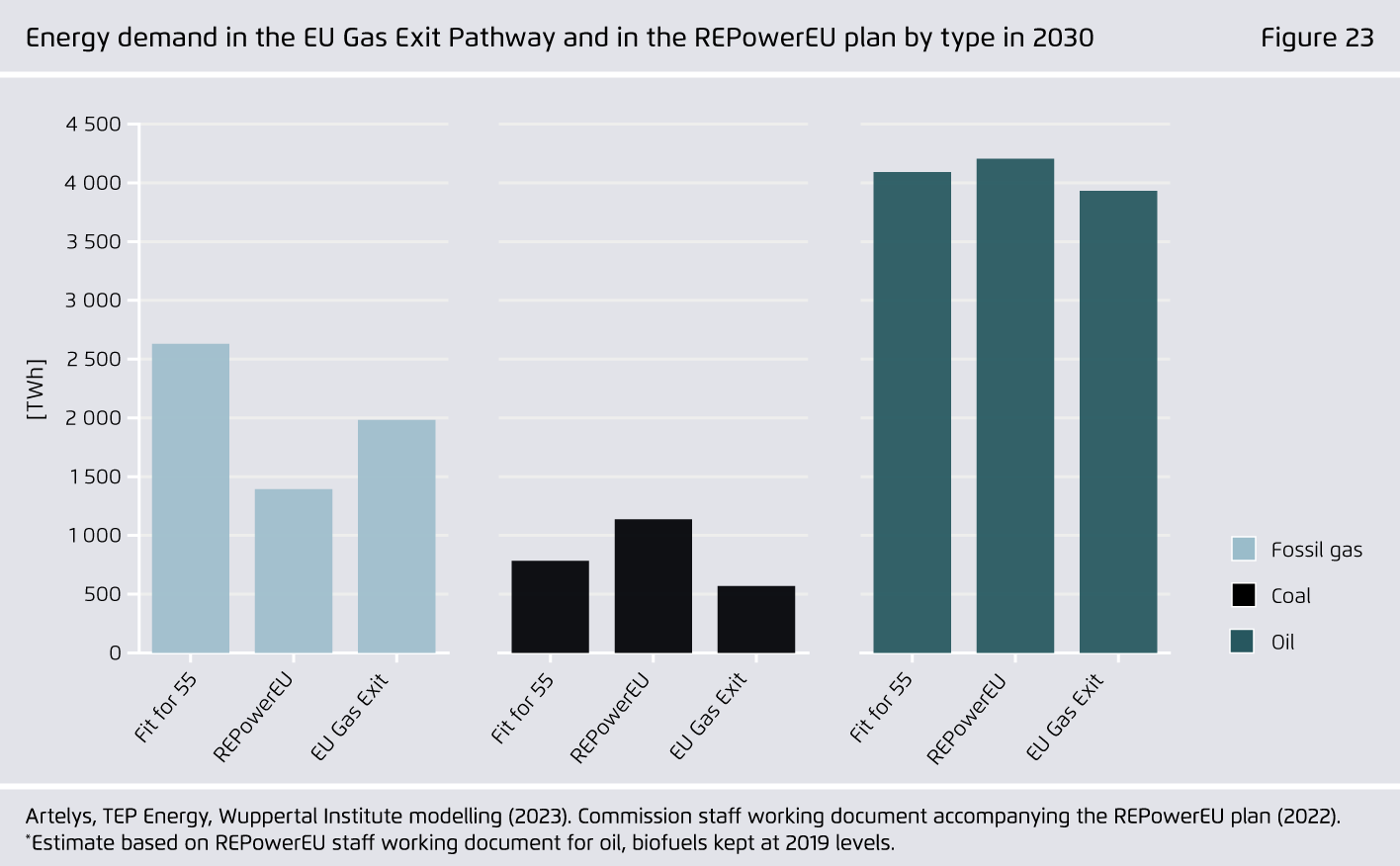
Under consideration of the Creative Commons license CC BY (attribution) the image may be further processed in any format or medium (also commercially, also in modified form), as long as the author is mentioned and a link to the license is given.
Supply by source and sectoral demand for renewable hydrogen and derivatives
Figure 24 from Breaking free from fossil gas on page 45
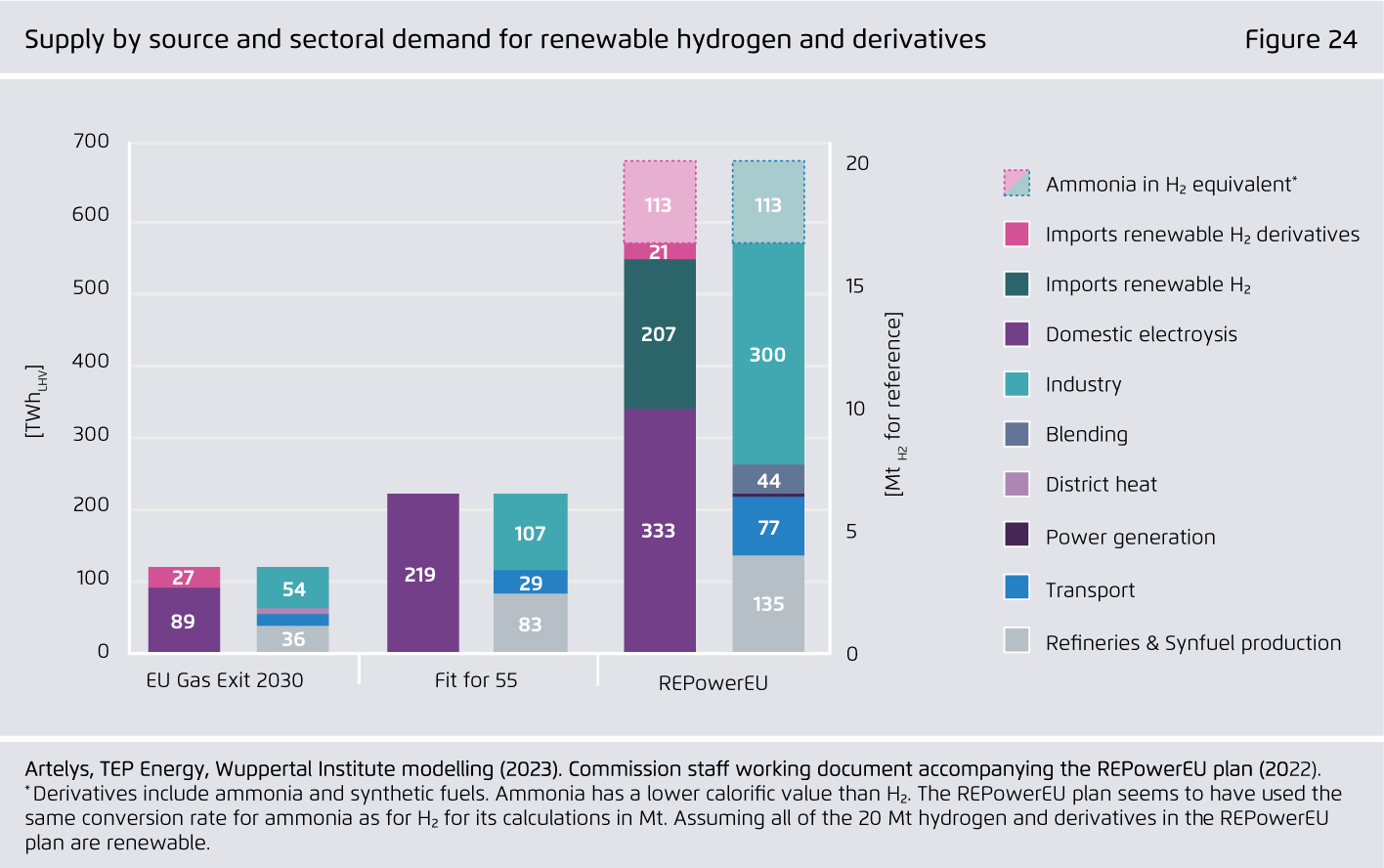
Under consideration of the Creative Commons license CC BY (attribution) the image may be further processed in any format or medium (also commercially, also in modified form), as long as the author is mentioned and a link to the license is given.
Scenario comparison – Biomass consumption vs sustainable supply potentials
Figure 25 from Breaking free from fossil gas on page 47
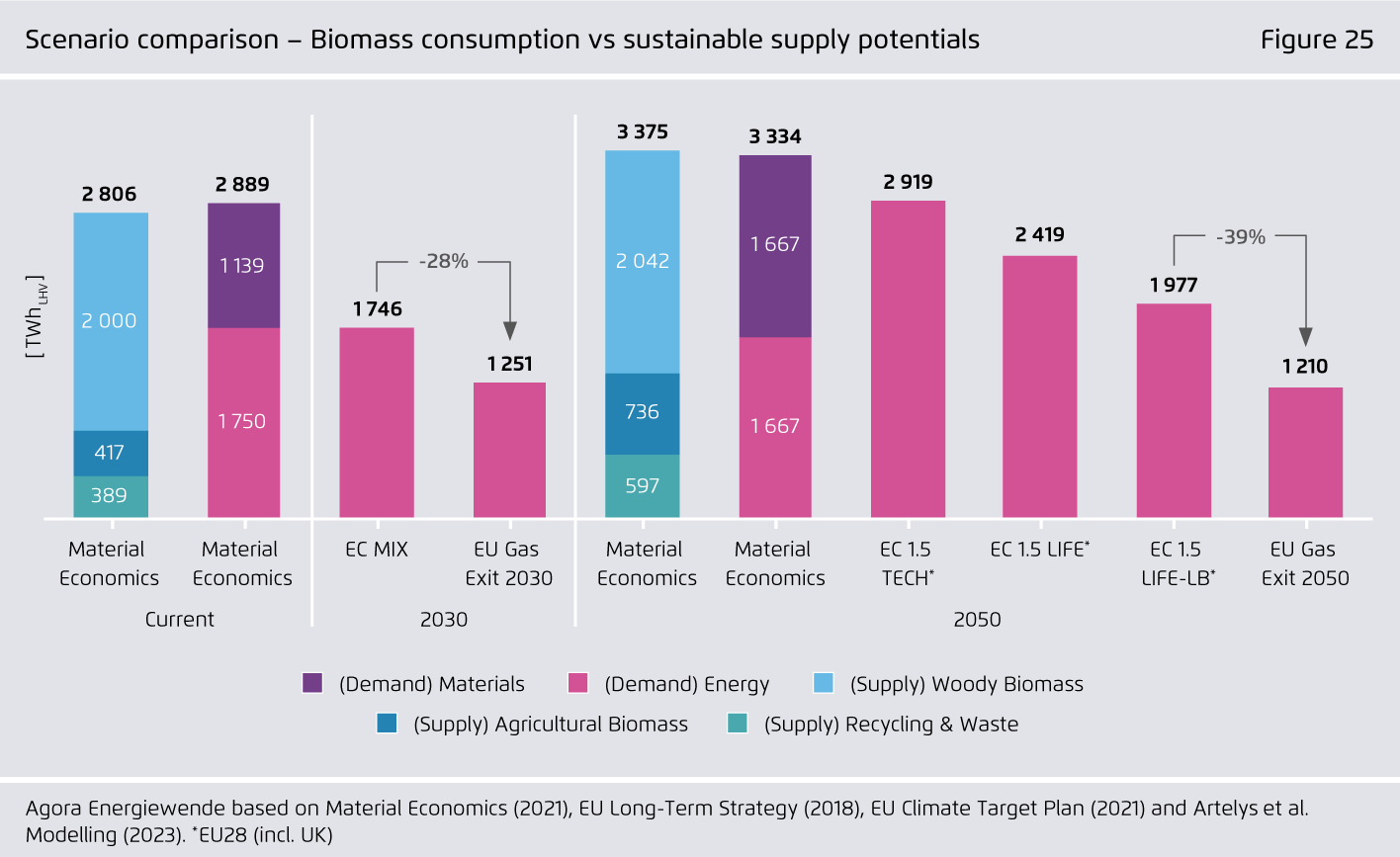
Under consideration of the Creative Commons license CC BY (attribution) the image may be further processed in any format or medium (also commercially, also in modified form), as long as the author is mentioned and a link to the license is given.
Scenario comparison – gas and H₂ derivatives in 2050
Figure 26 from Breaking free from fossil gas on page 50
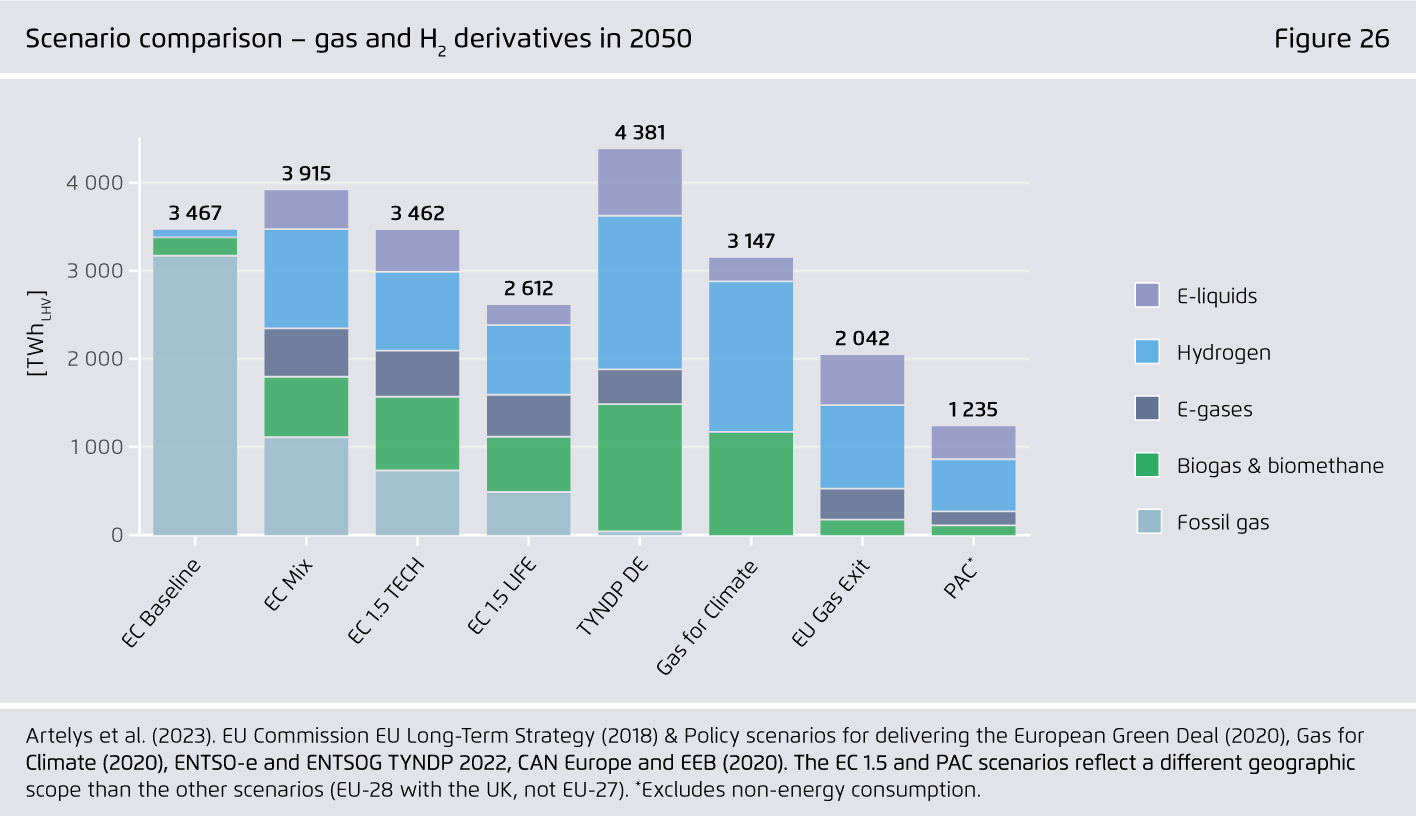
Under consideration of the Creative Commons license CC BY (attribution) the image may be further processed in any format or medium (also commercially, also in modified form), as long as the author is mentioned and a link to the license is given.
EU gas supply by source and import dependency in the EU Gas Exit Pathway
Figure 27 from Breaking free from fossil gas on page 52
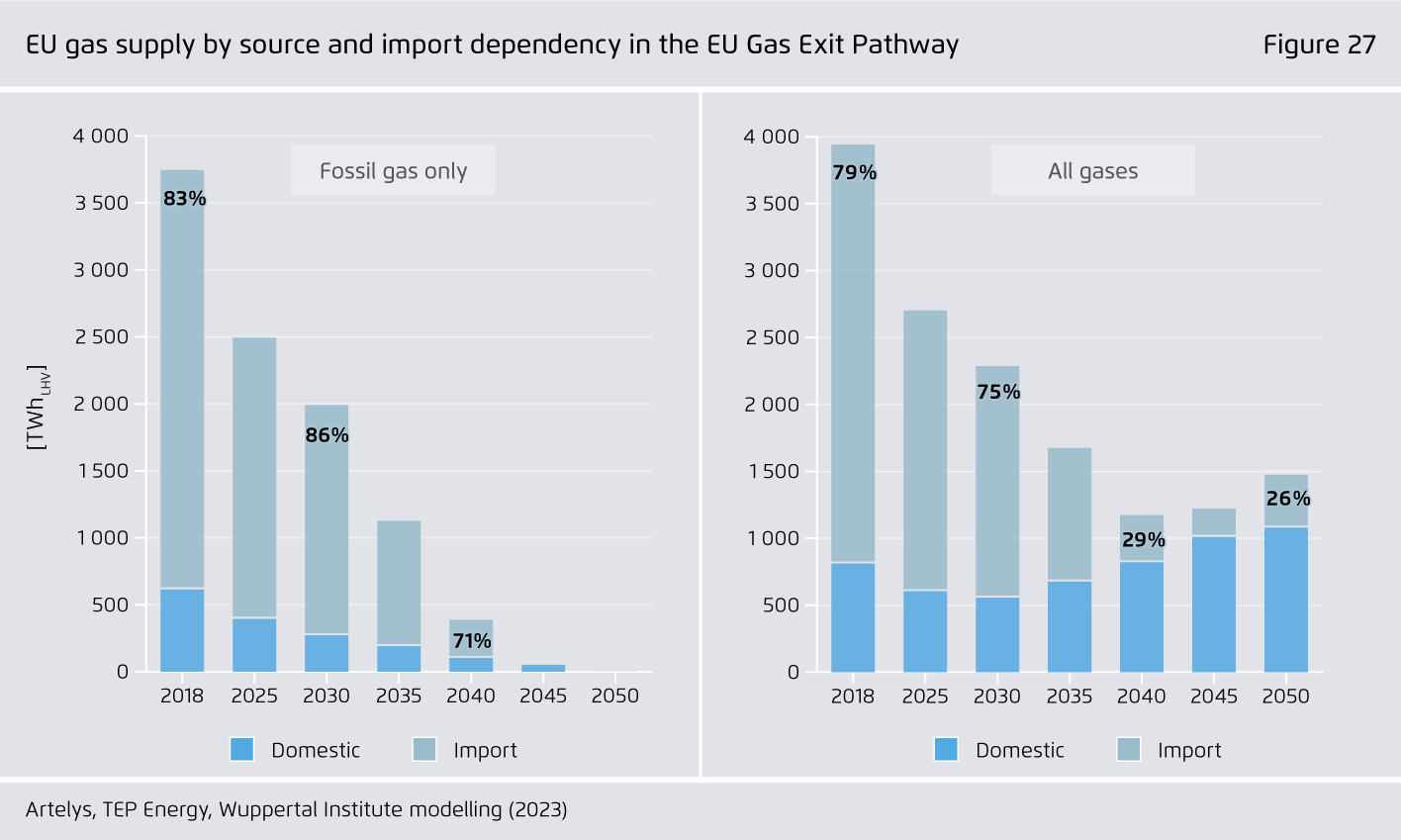
Under consideration of the Creative Commons license CC BY (attribution) the image may be further processed in any format or medium (also commercially, also in modified form), as long as the author is mentioned and a link to the license is given.
Hydrogen demand by sector and supply by origin
Figure 28 from Breaking free from fossil gas on page 54
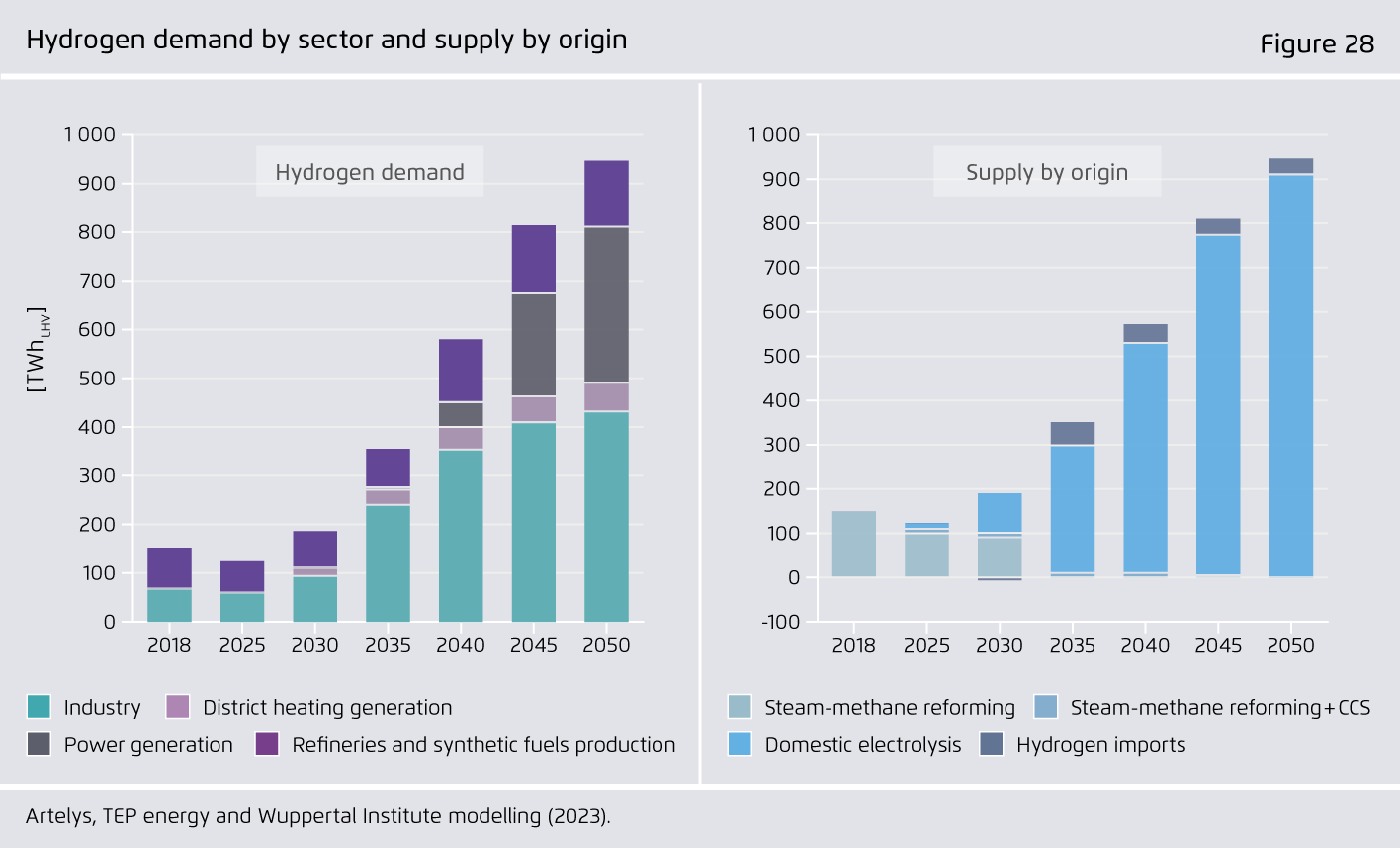
Under consideration of the Creative Commons license CC BY (attribution) the image may be further processed in any format or medium (also commercially, also in modified form), as long as the author is mentioned and a link to the license is given.
Cumulative investment per ten-year period
Figure 29 from Breaking free from fossil gas on page 57
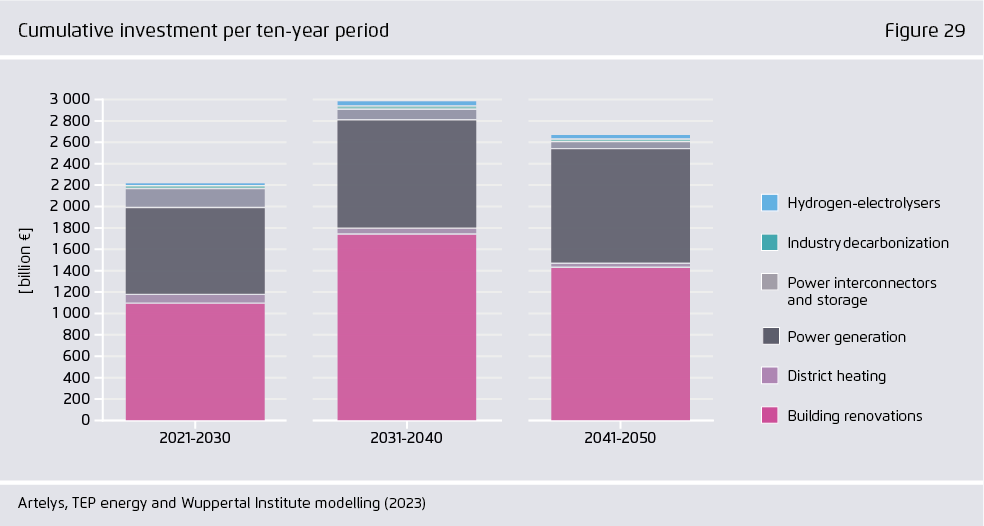
Under consideration of the Creative Commons license CC BY (attribution) the image may be further processed in any format or medium (also commercially, also in modified form), as long as the author is mentioned and a link to the license is given.
Annual average investment needs and EU fundings in 2021-2030 in diff erent regions
Figure 30 from Breaking free from fossil gas on page 58
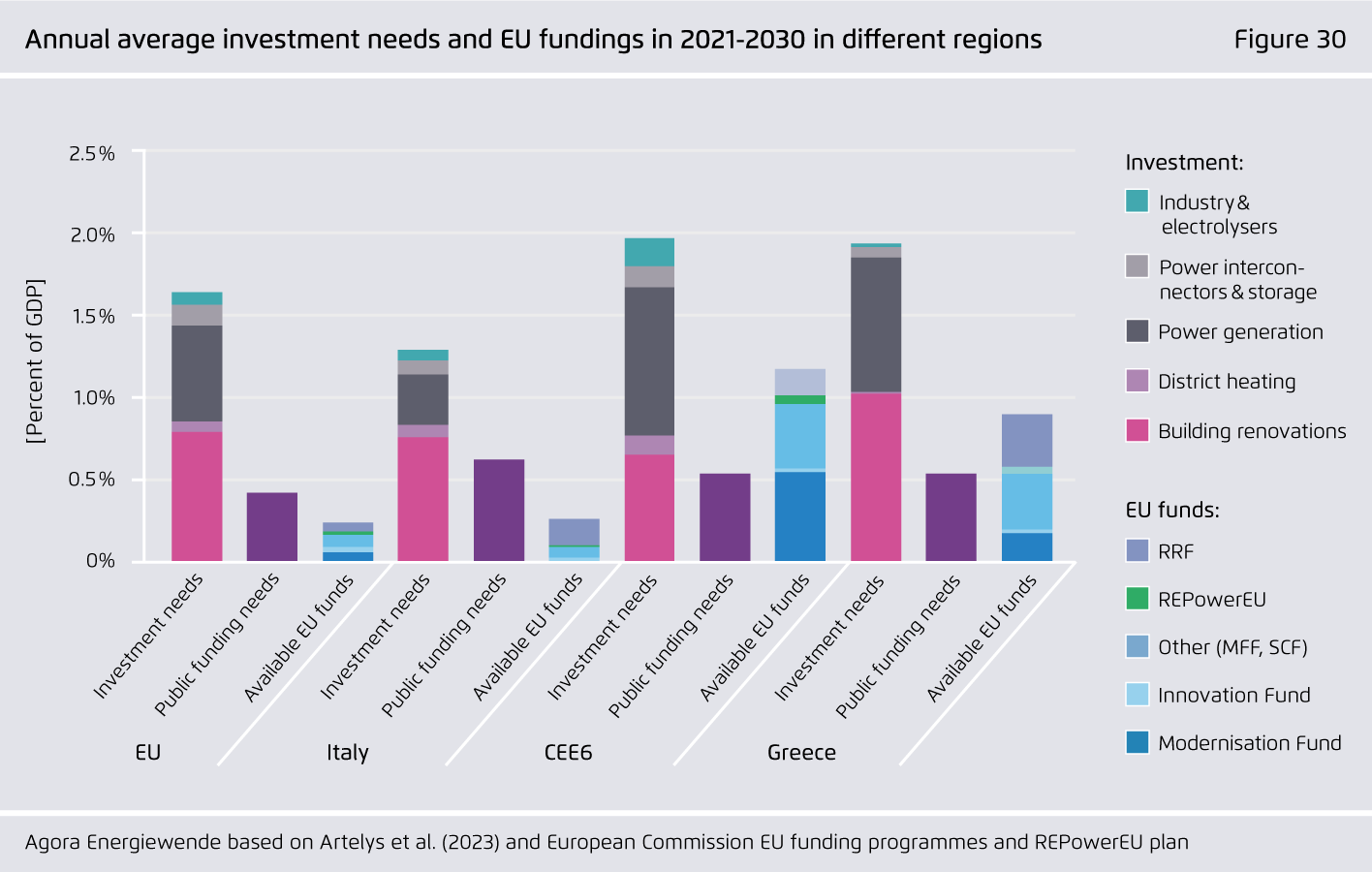
Under consideration of the Creative Commons license CC BY (attribution) the image may be further processed in any format or medium (also commercially, also in modified form), as long as the author is mentioned and a link to the license is given.
Relative dependence on Russia as a fossil gas supplier (in %)
Figure A 1 from Breaking free from fossil gas on page 75
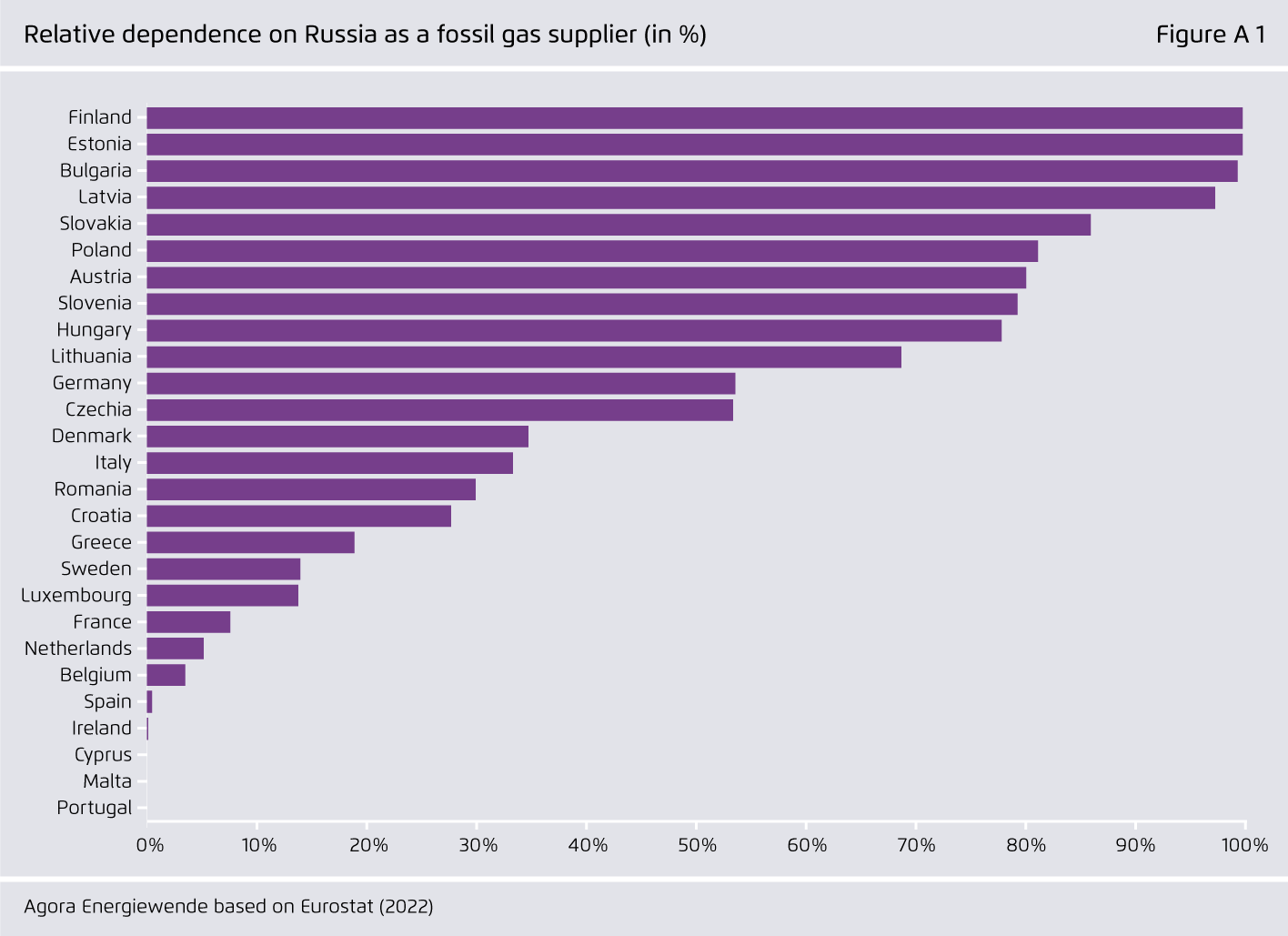
Under consideration of the Creative Commons license CC BY (attribution) the image may be further processed in any format or medium (also commercially, also in modified form), as long as the author is mentioned and a link to the license is given.
Fossil gas demand and supply by source, EU-27
Figure A 2 from Breaking free from fossil gas on page 76
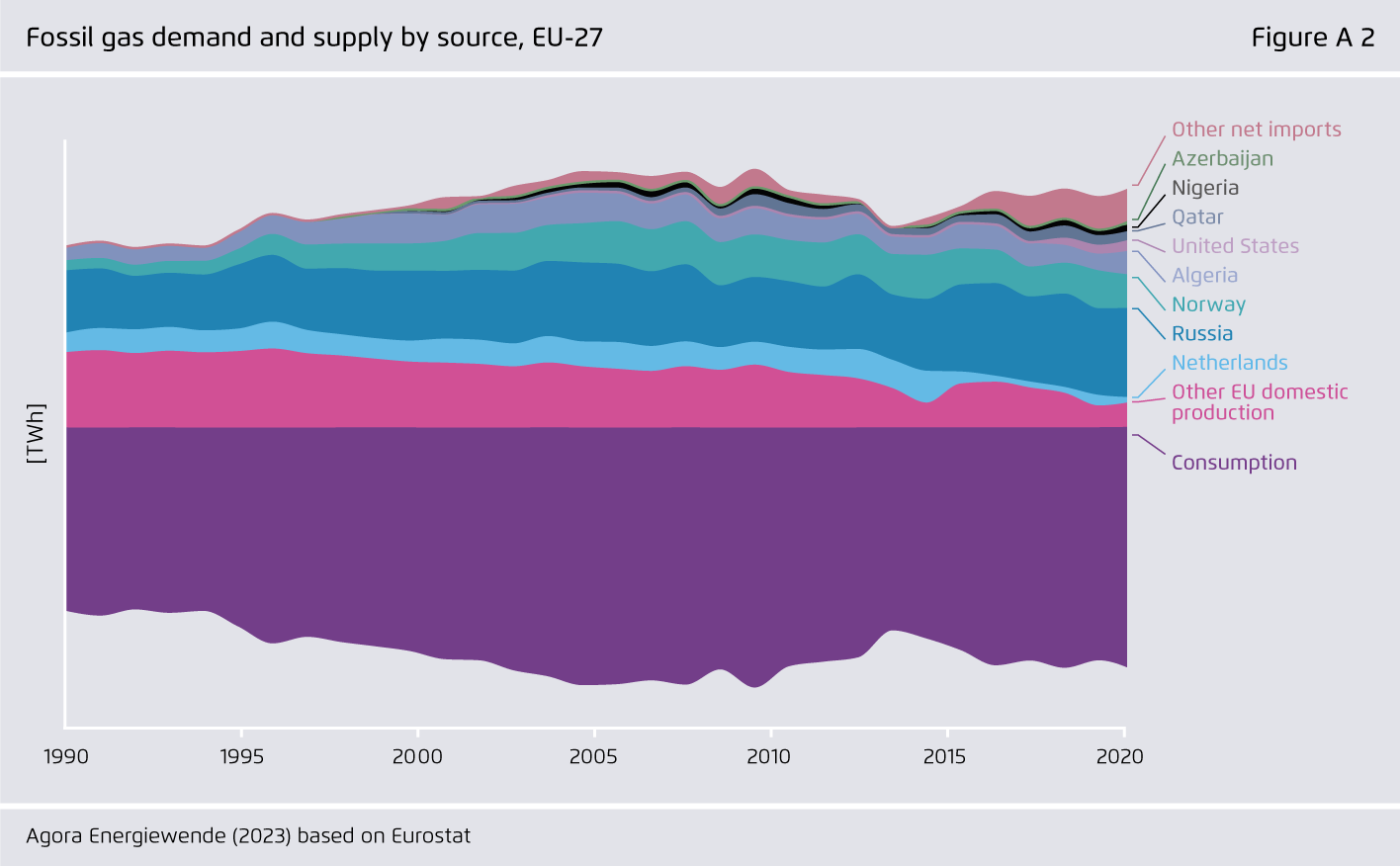
Under consideration of the Creative Commons license CC BY (attribution) the image may be further processed in any format or medium (also commercially, also in modified form), as long as the author is mentioned and a link to the license is given.
Fossil gas consumption in 2020 and MS share in EU consumption
Figure A3 from Breaking free from fossil gas on page 77
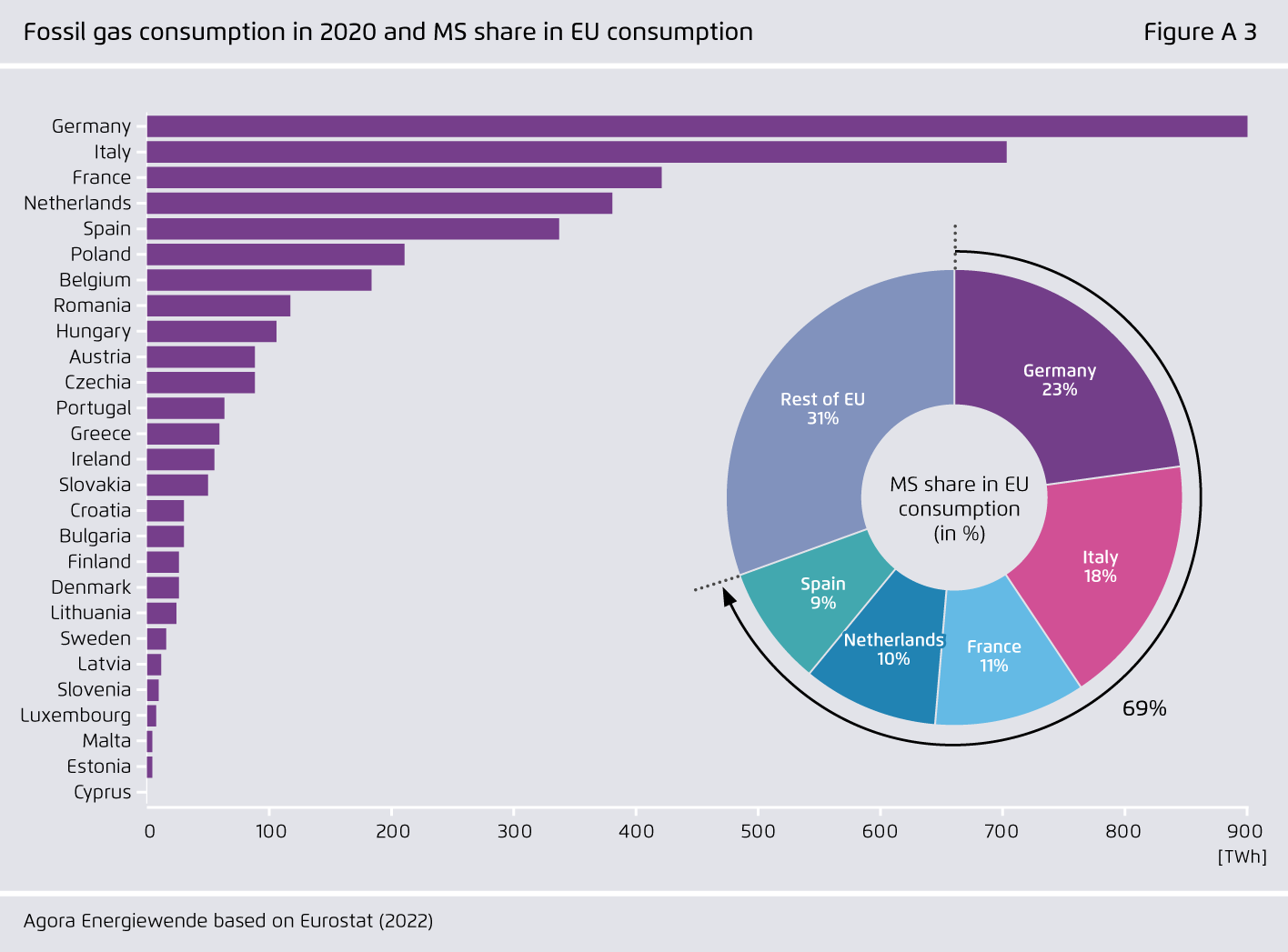
Under consideration of the Creative Commons license CC BY (attribution) the image may be further processed in any format or medium (also commercially, also in modified form), as long as the author is mentioned and a link to the license is given.
Relative share of gas consuption in gross primary energy demand in 2020
Figure A 4 from Breaking free from fossil gas on page 78
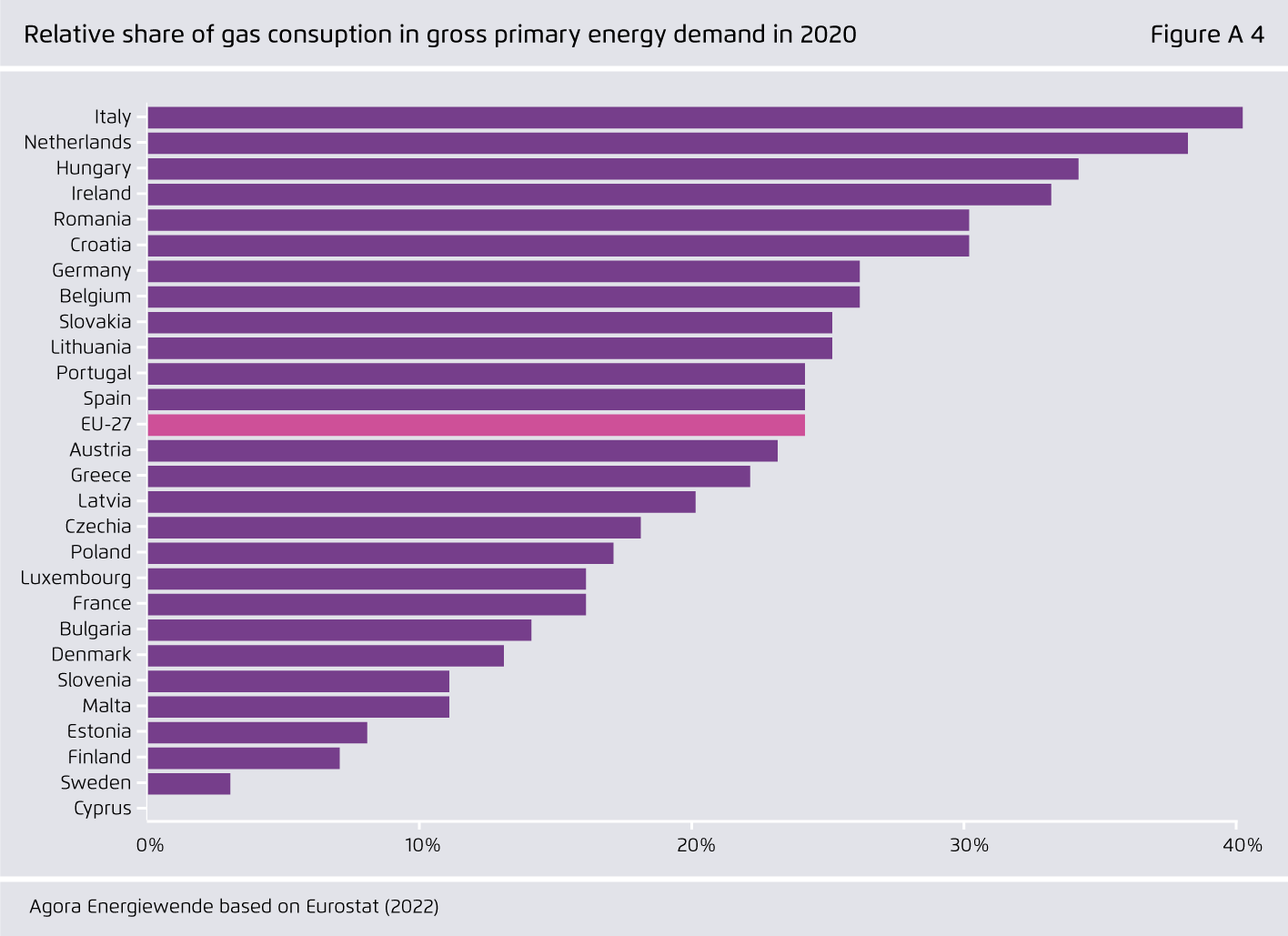
Under consideration of the Creative Commons license CC BY (attribution) the image may be further processed in any format or medium (also commercially, also in modified form), as long as the author is mentioned and a link to the license is given.







